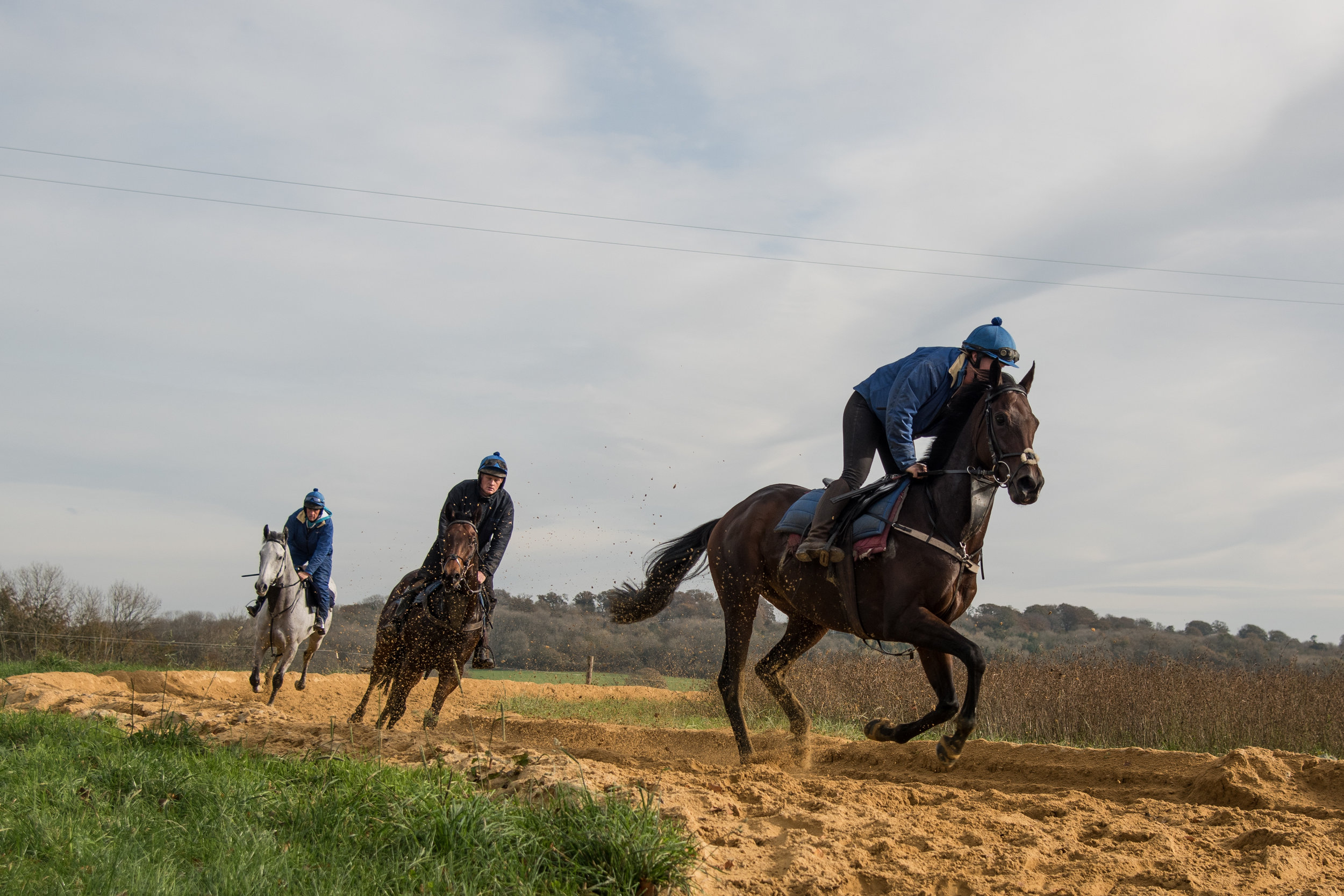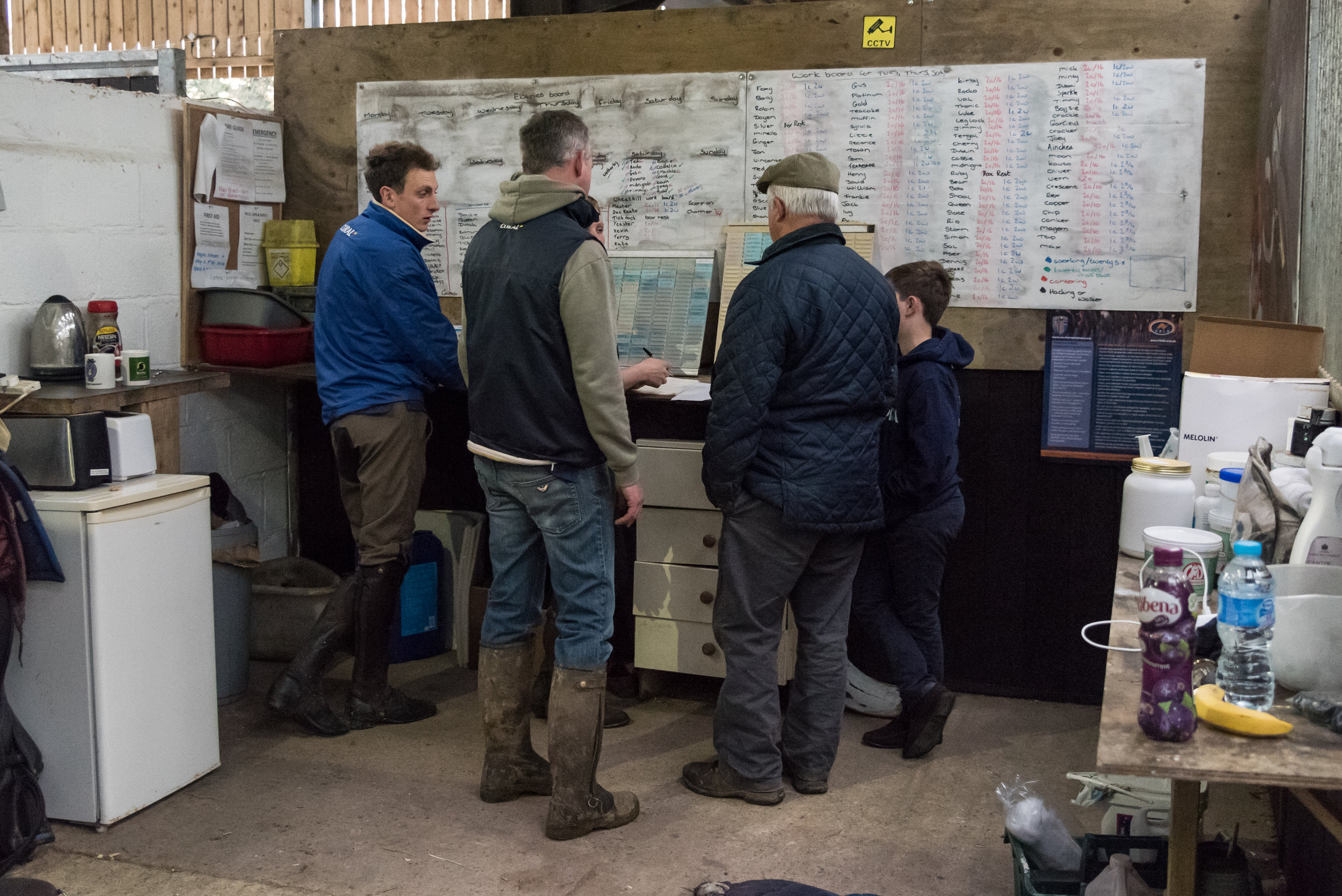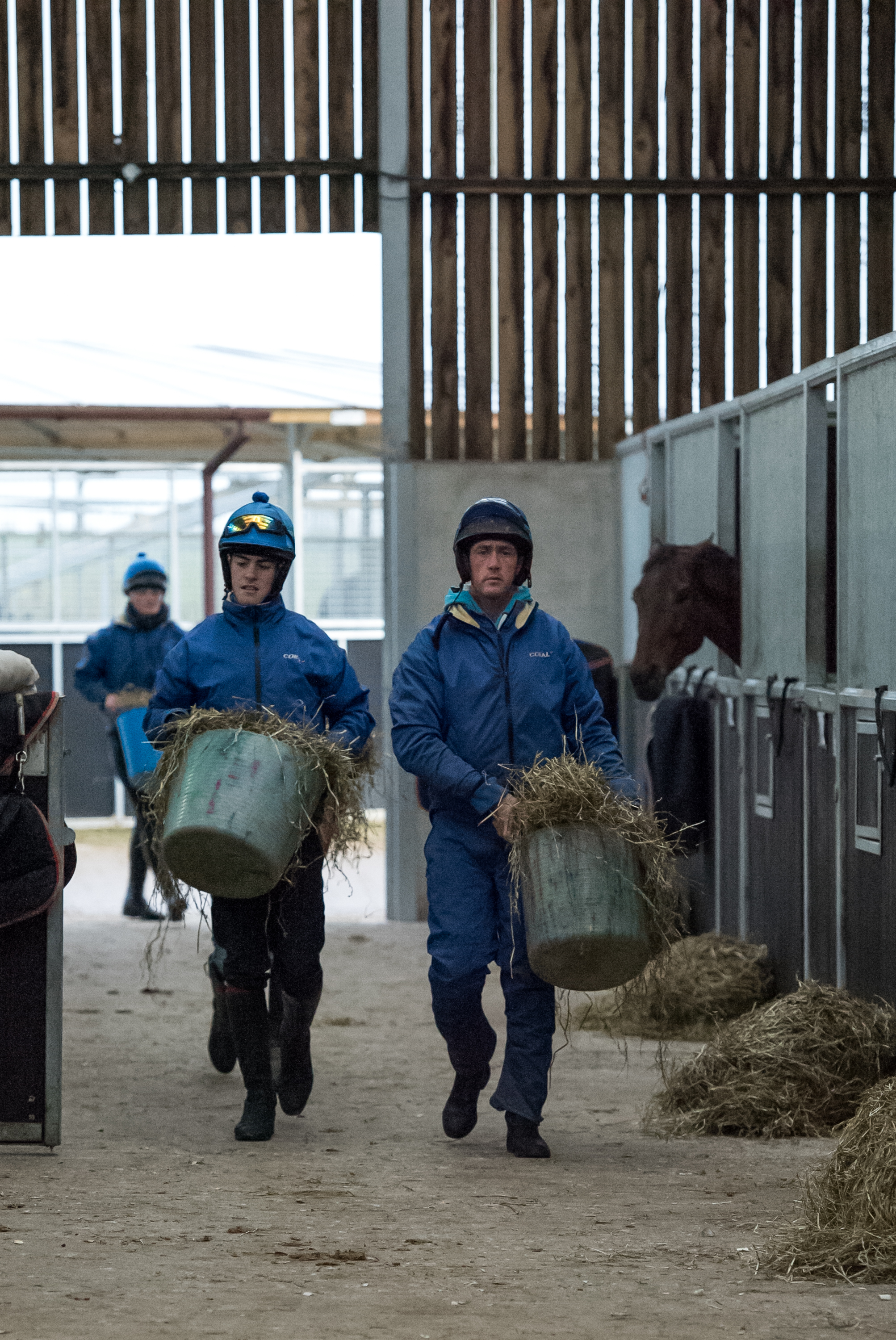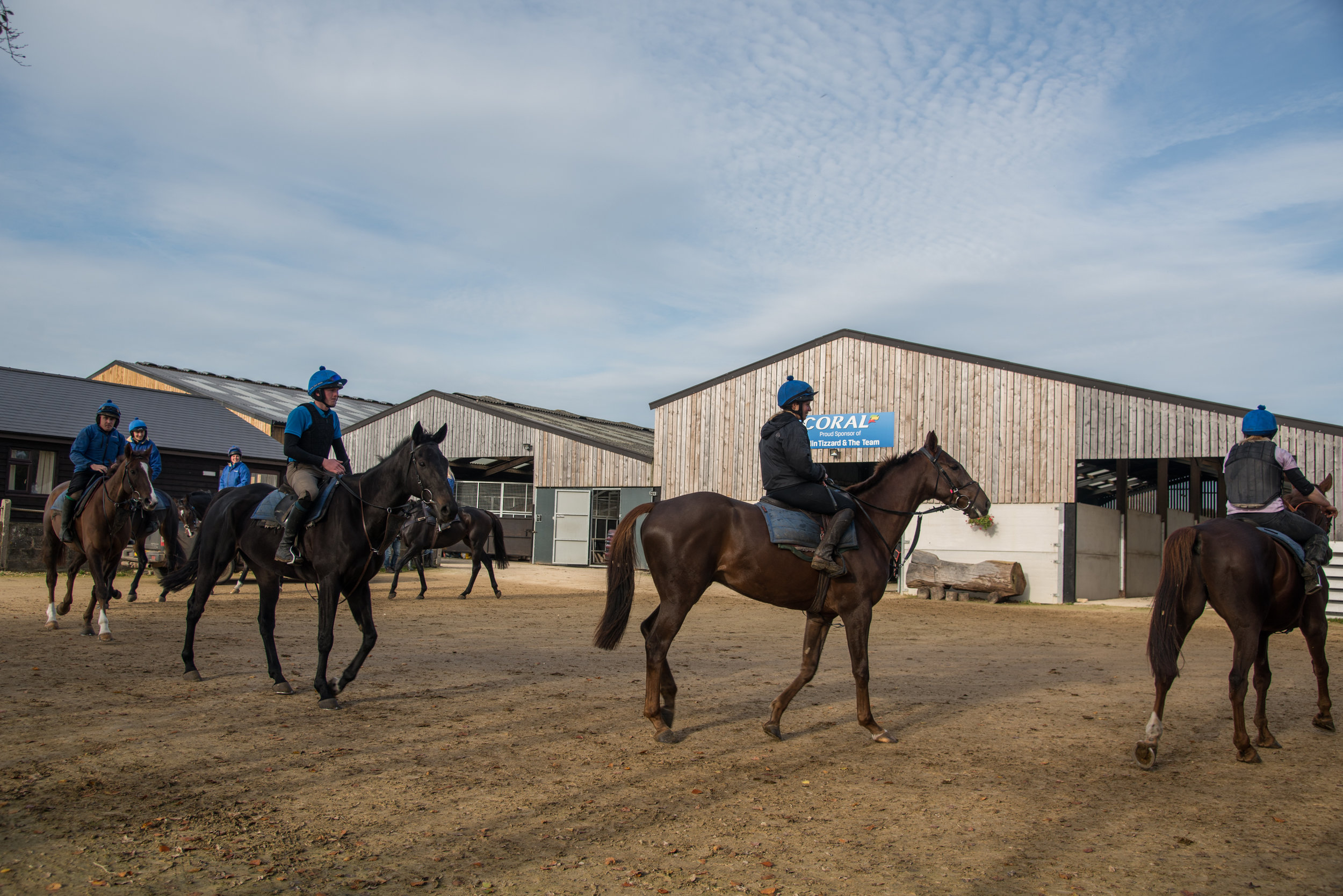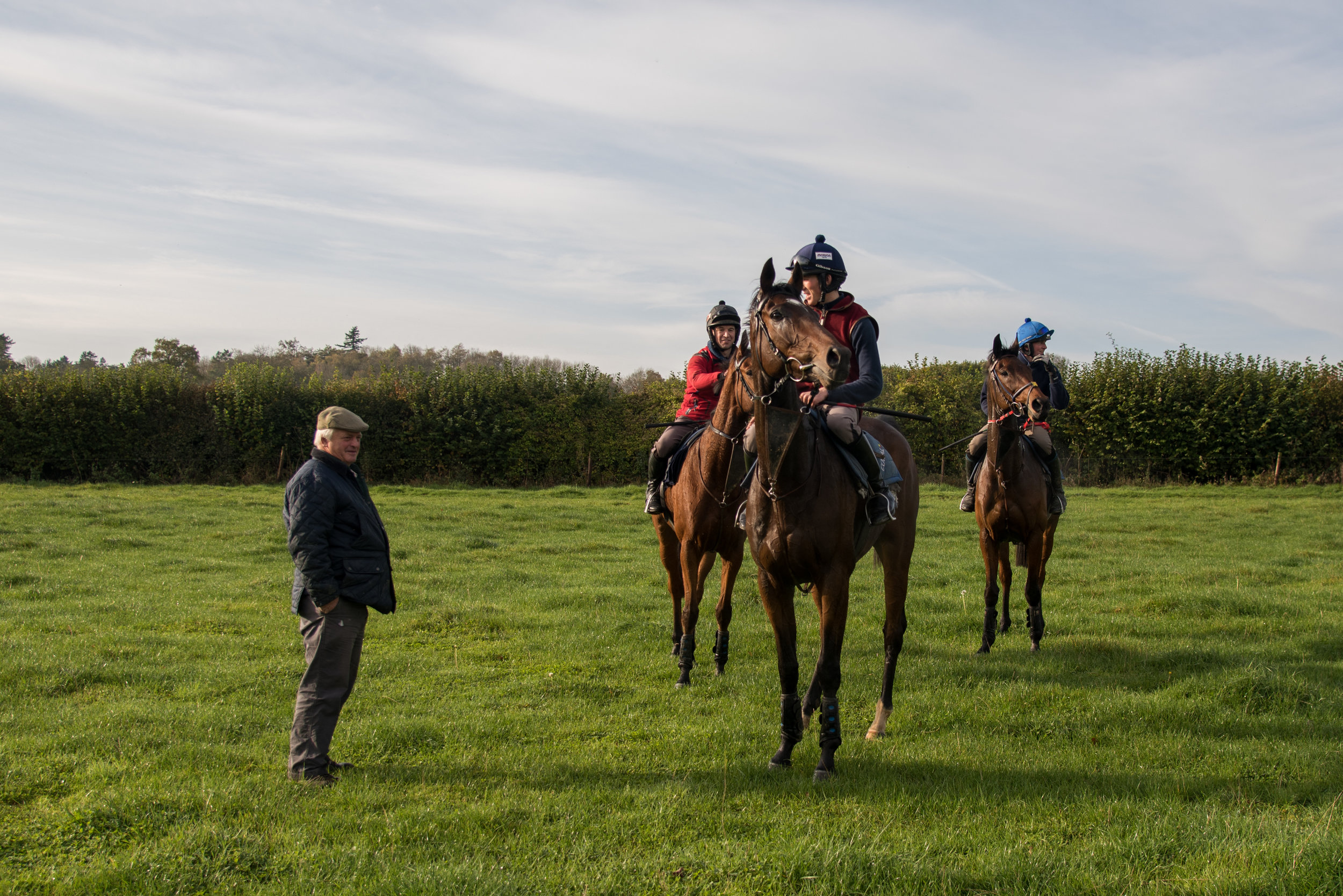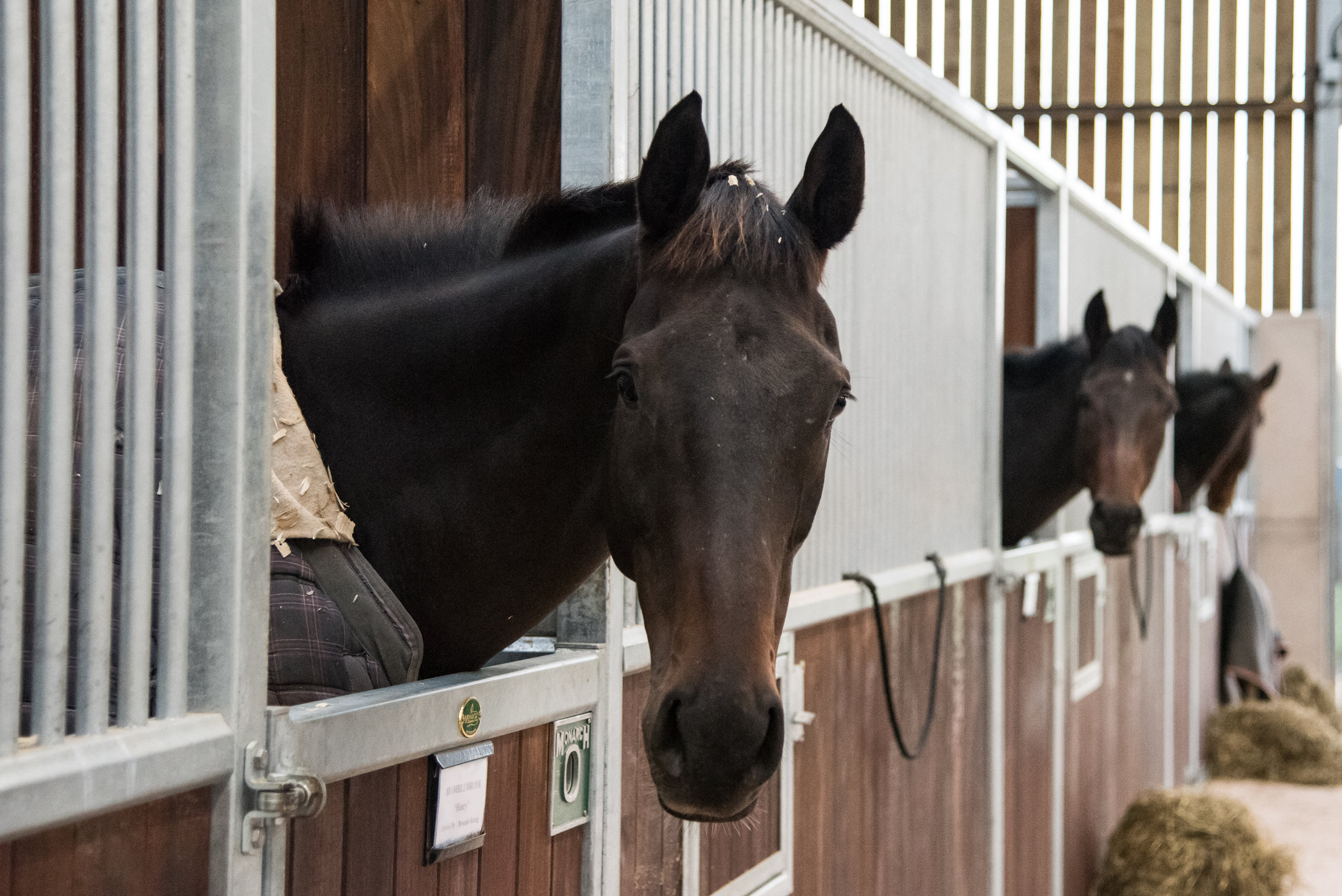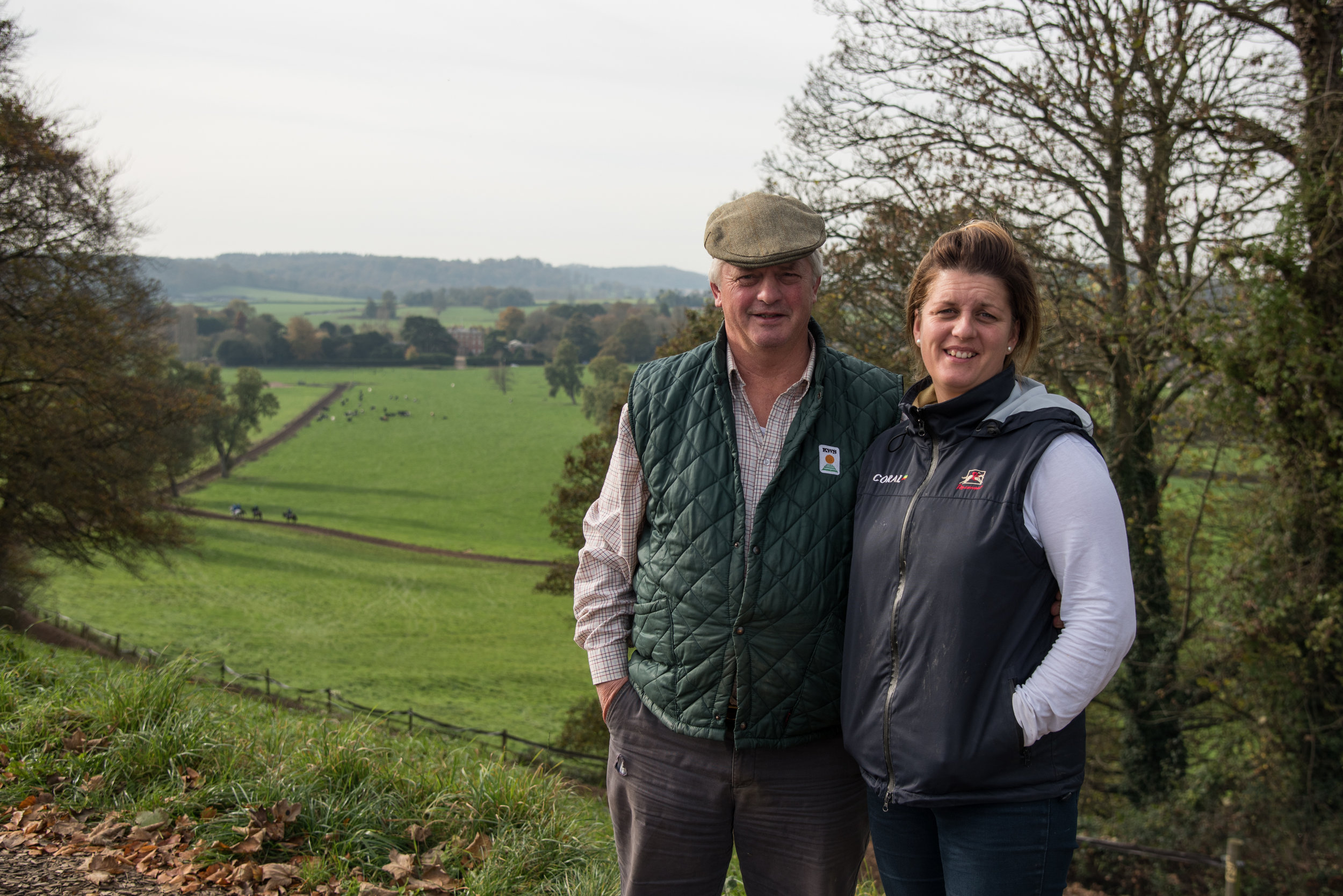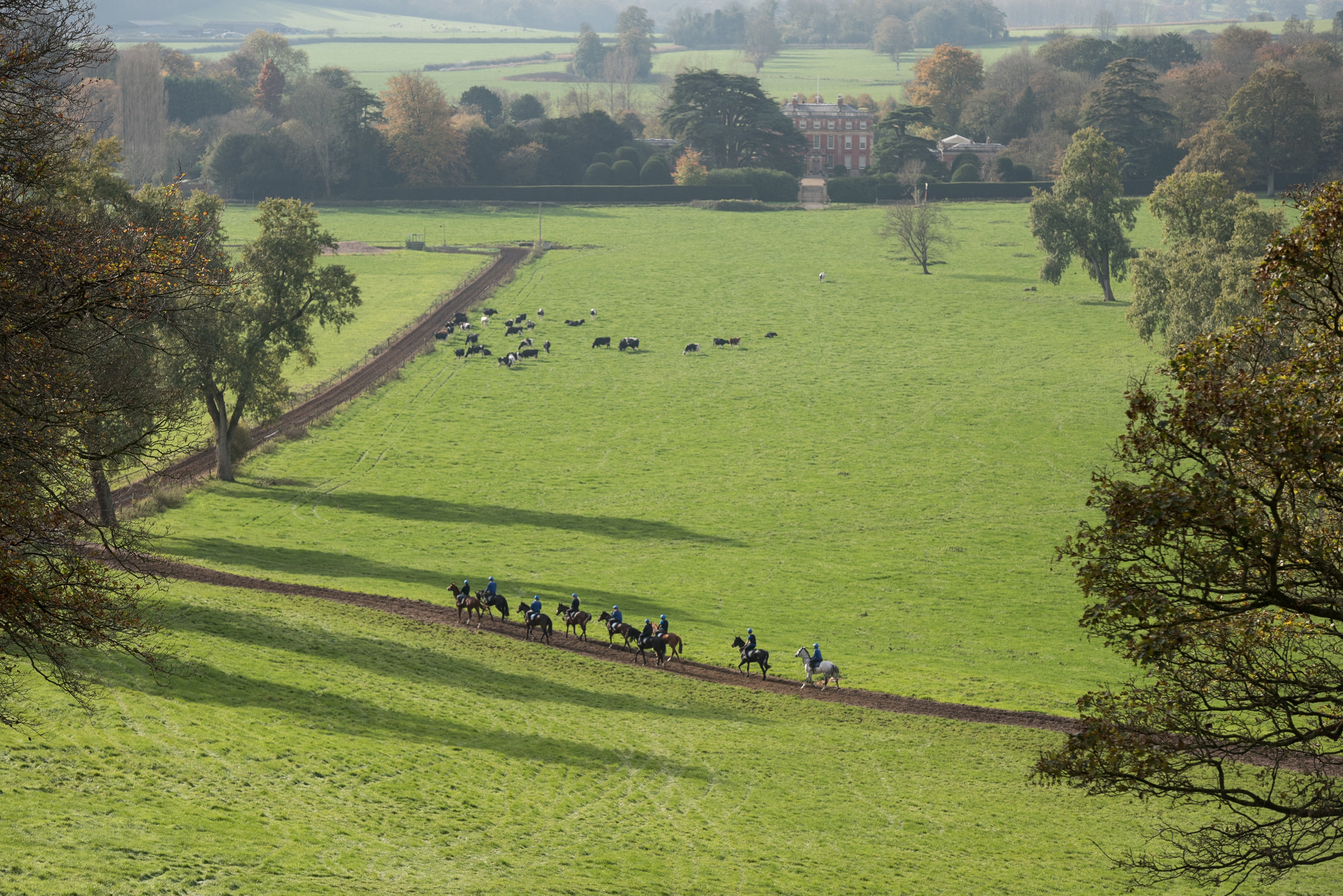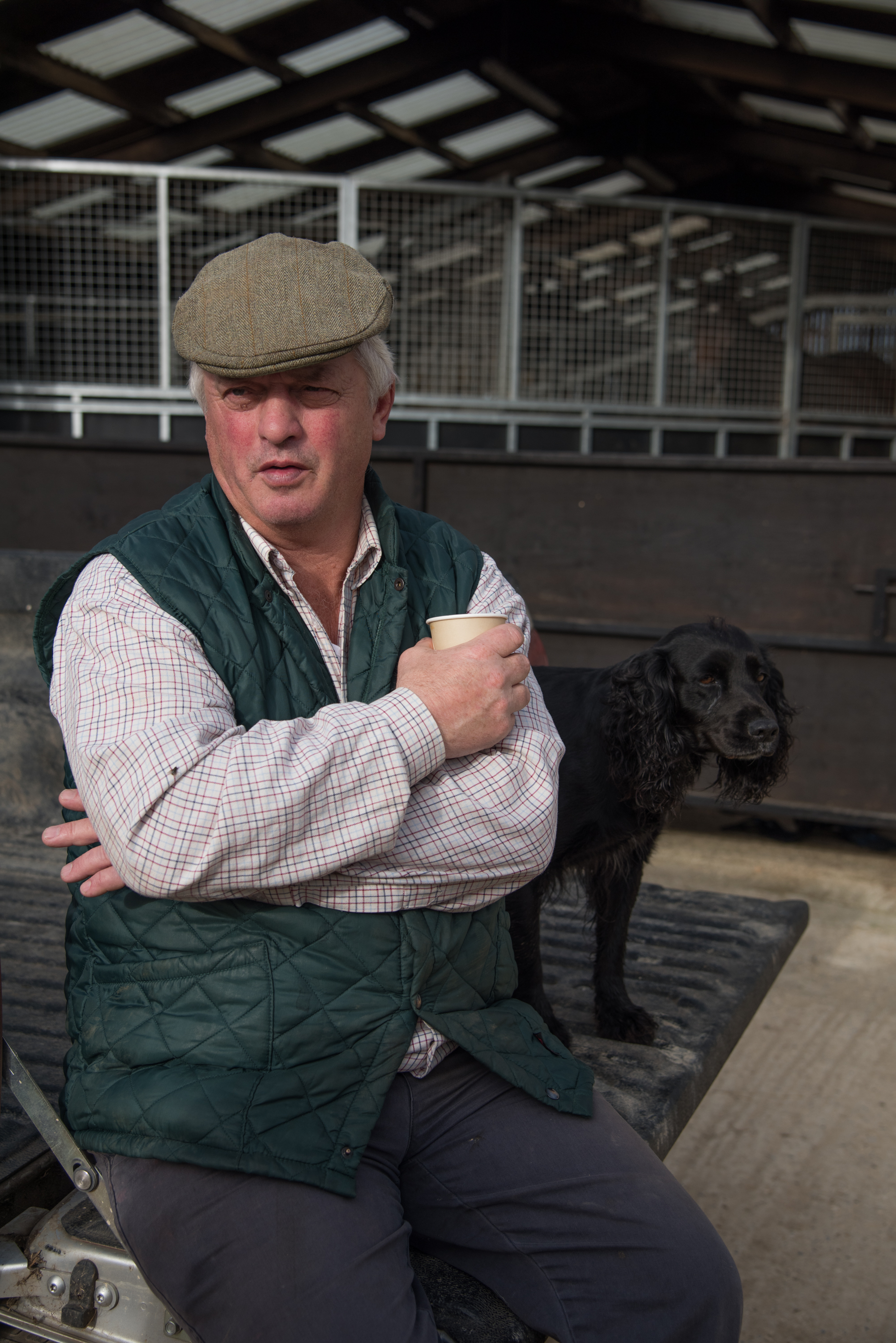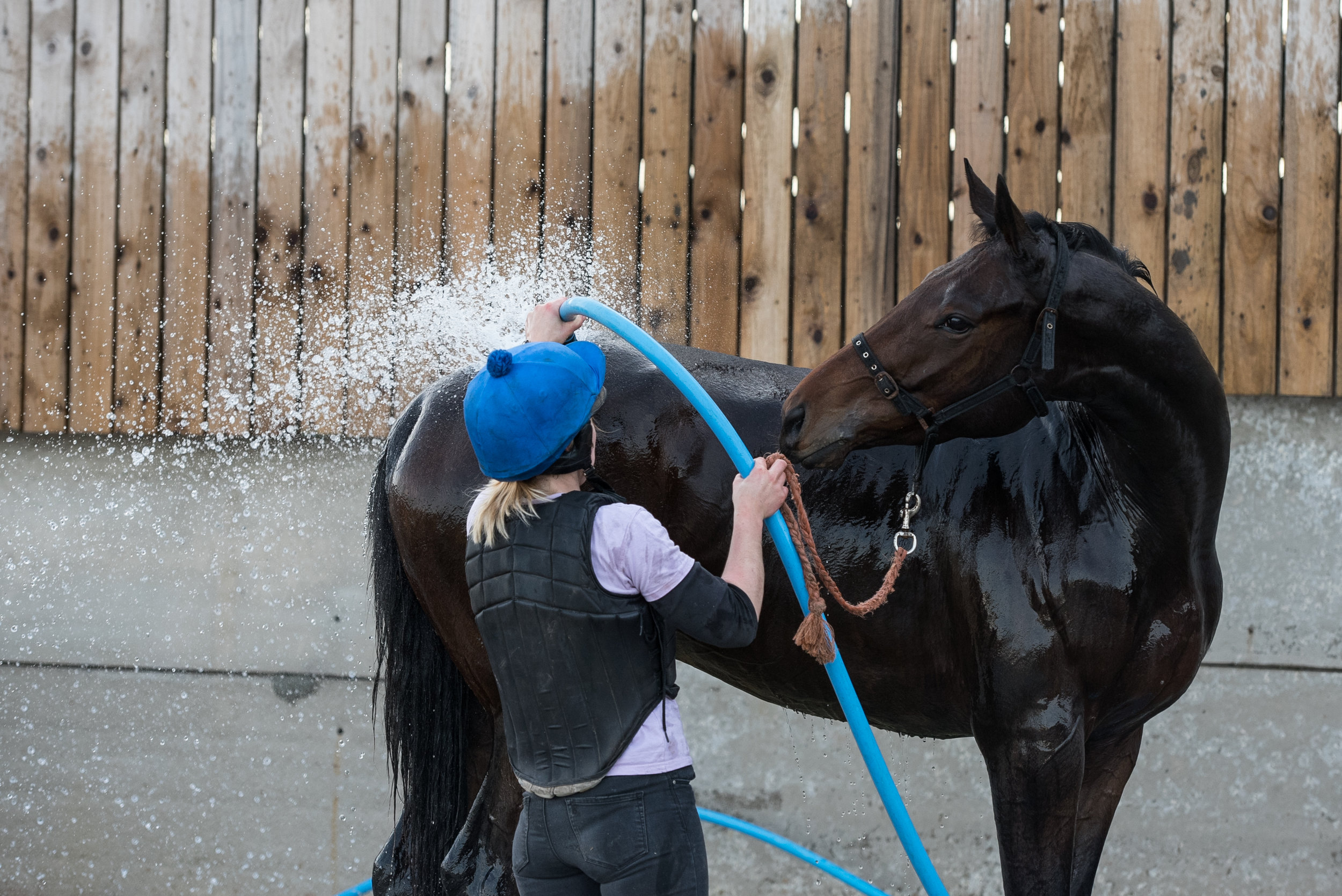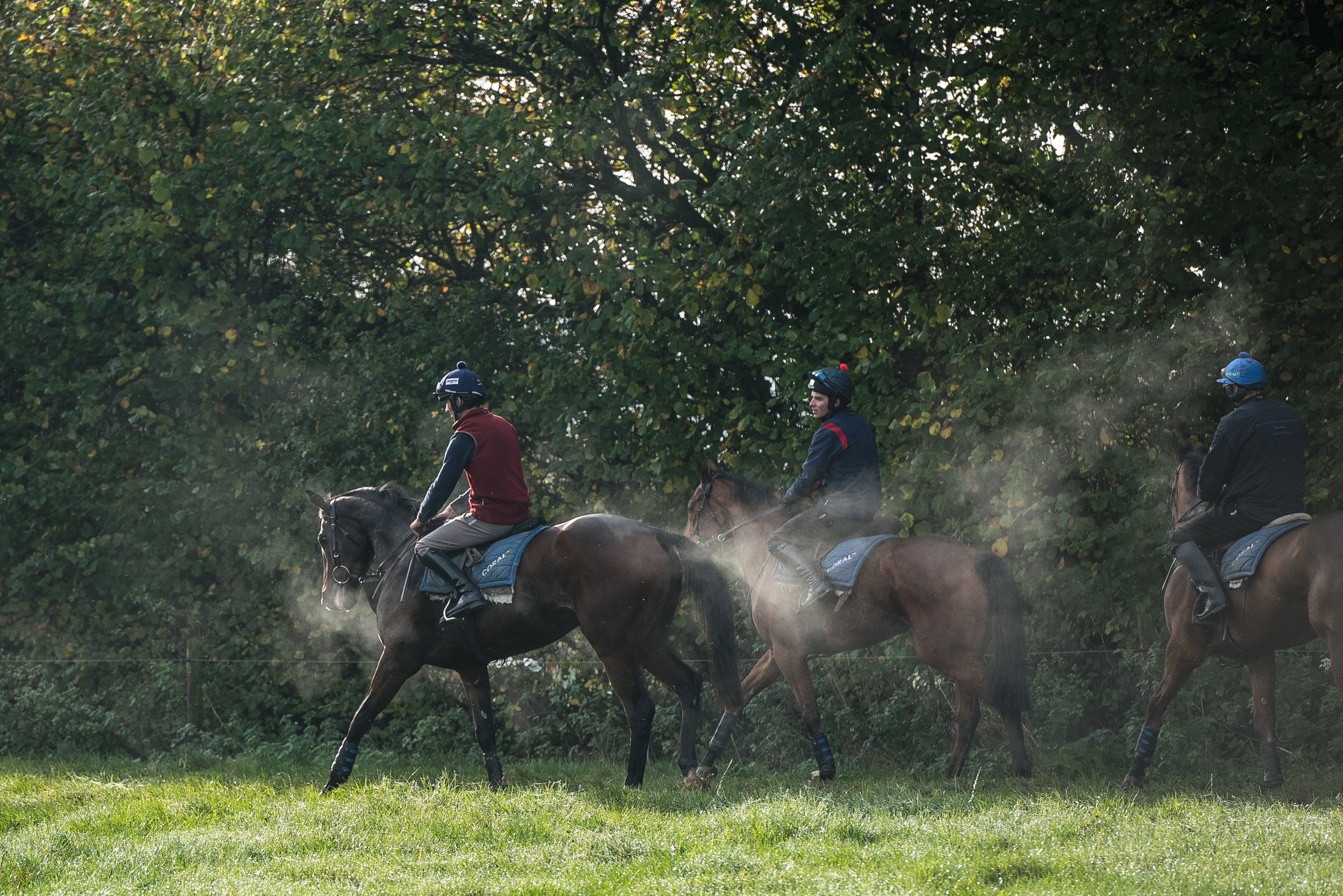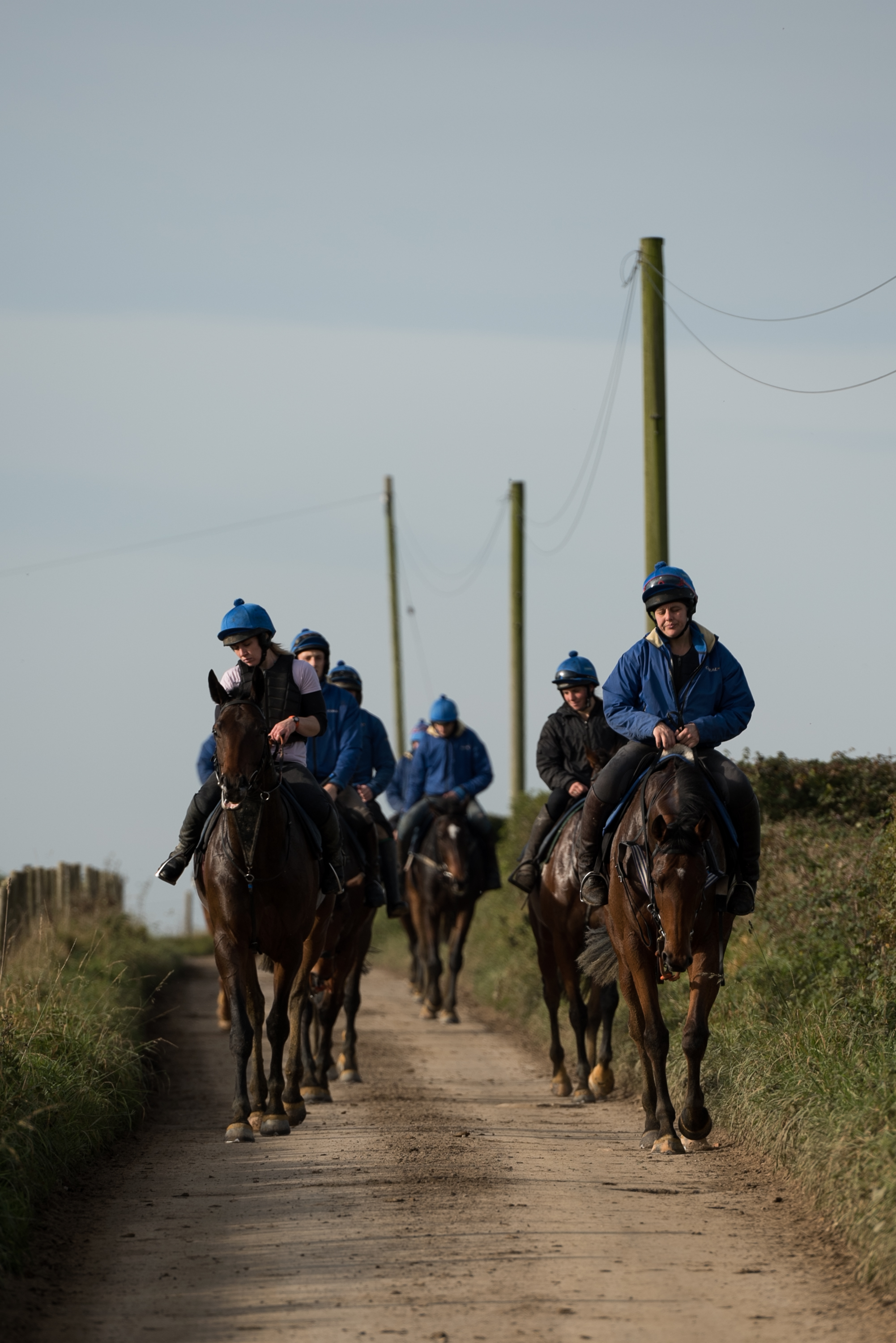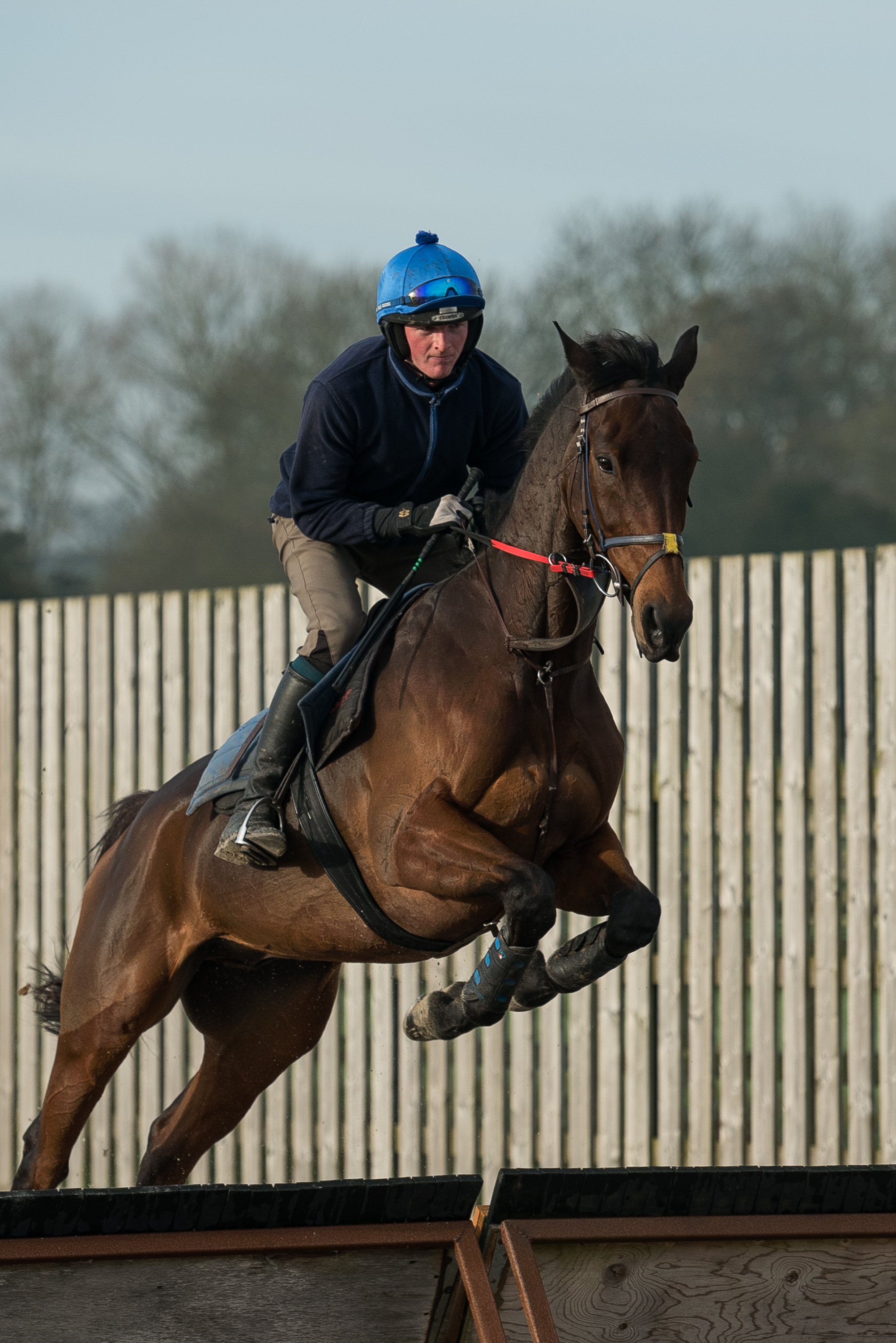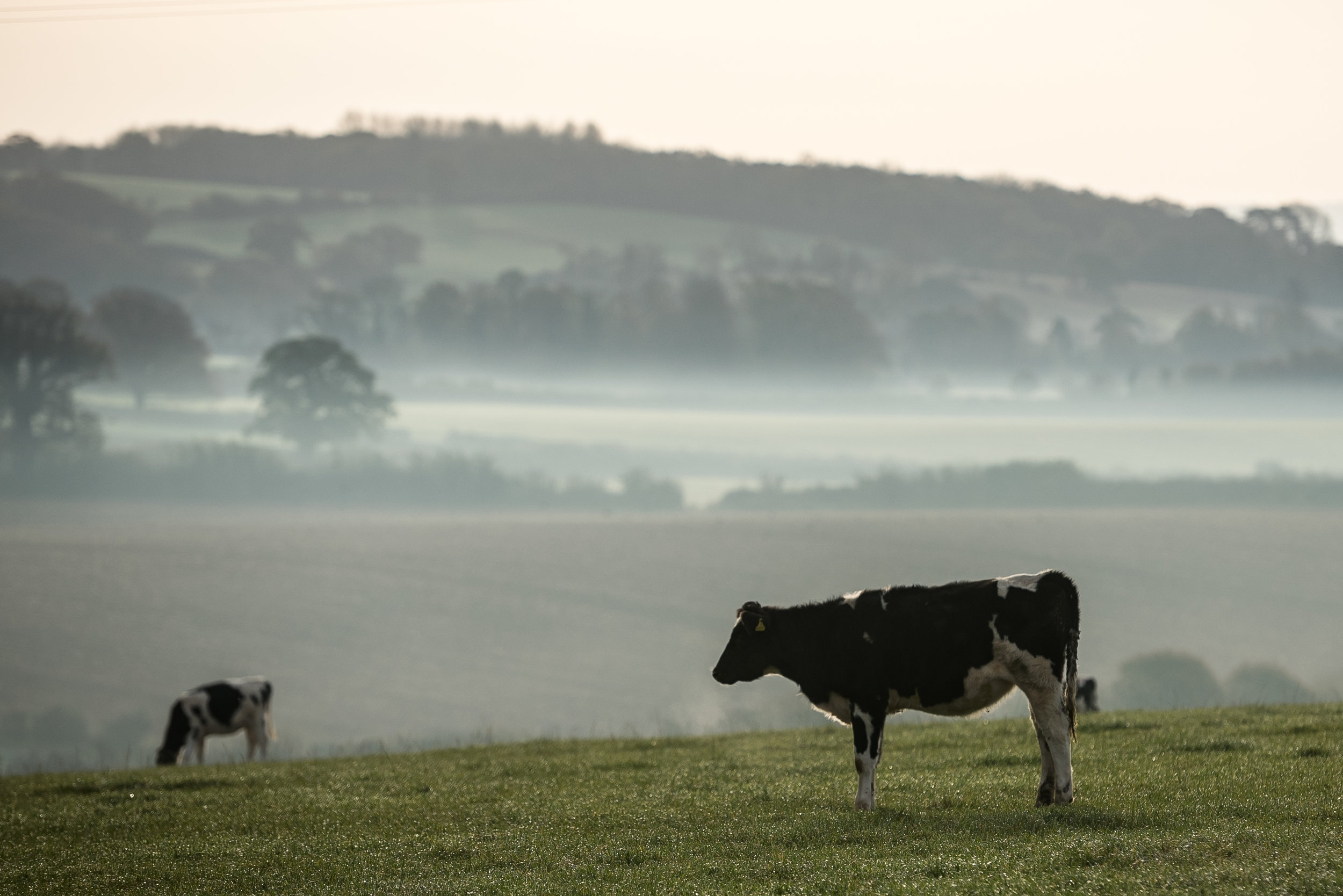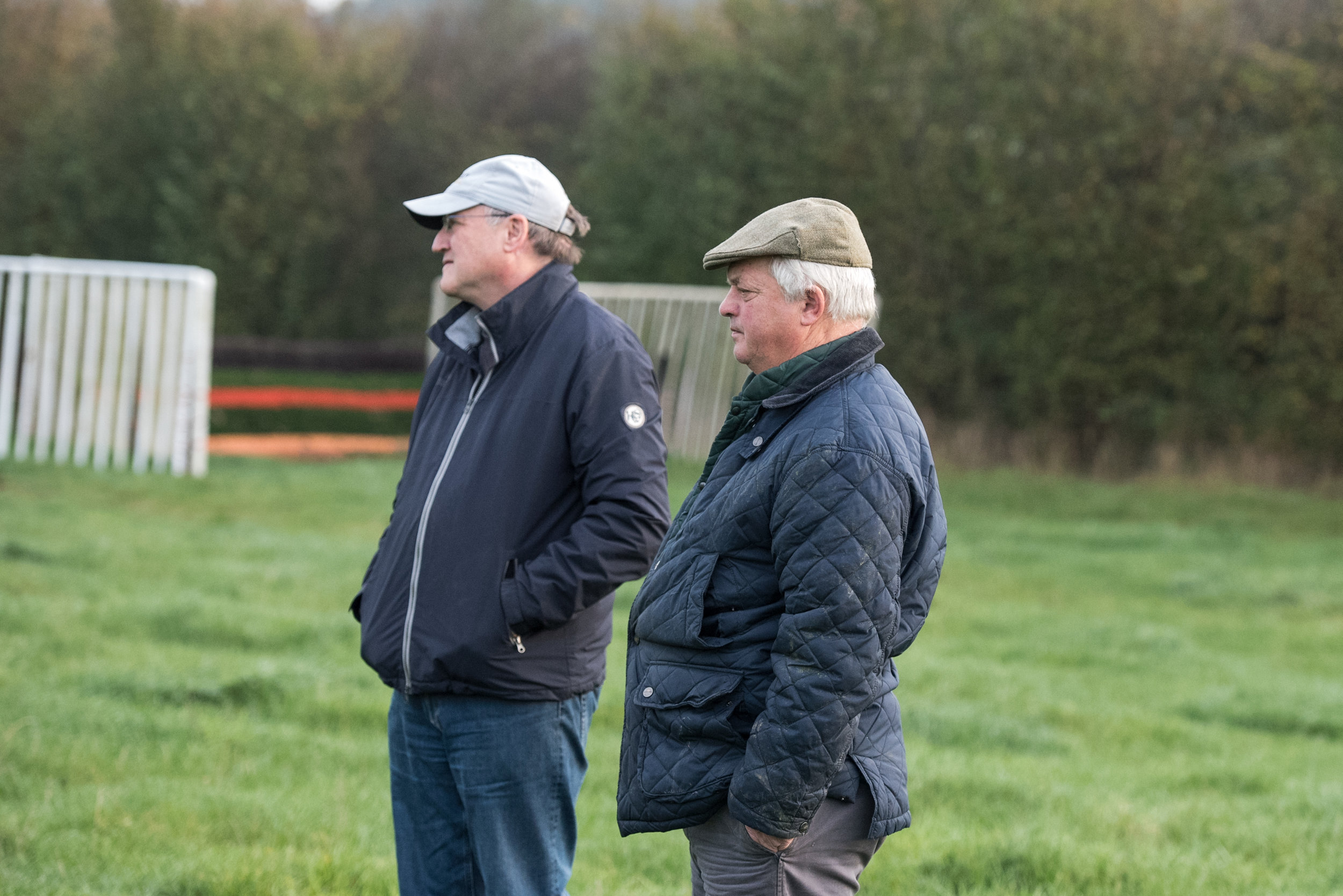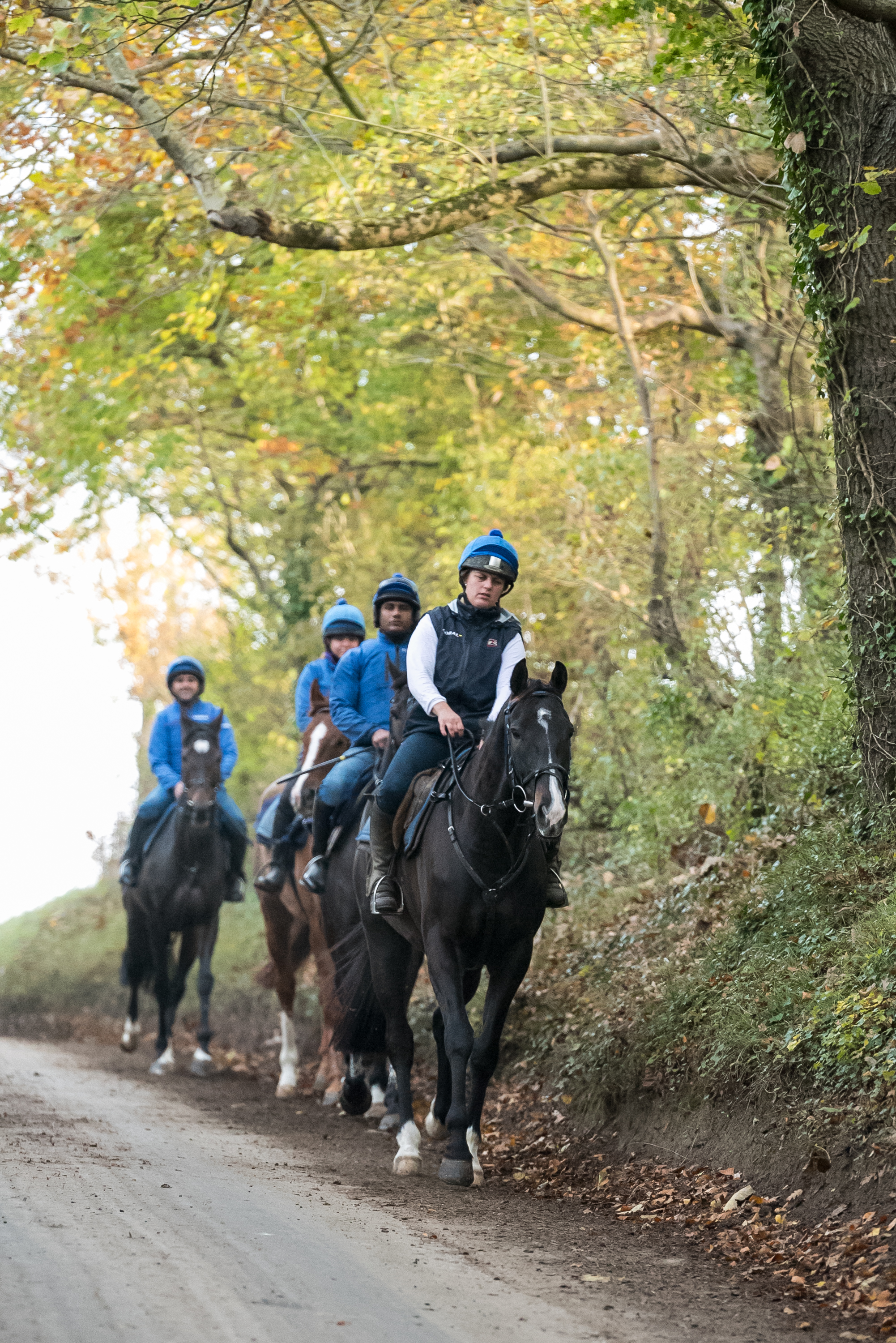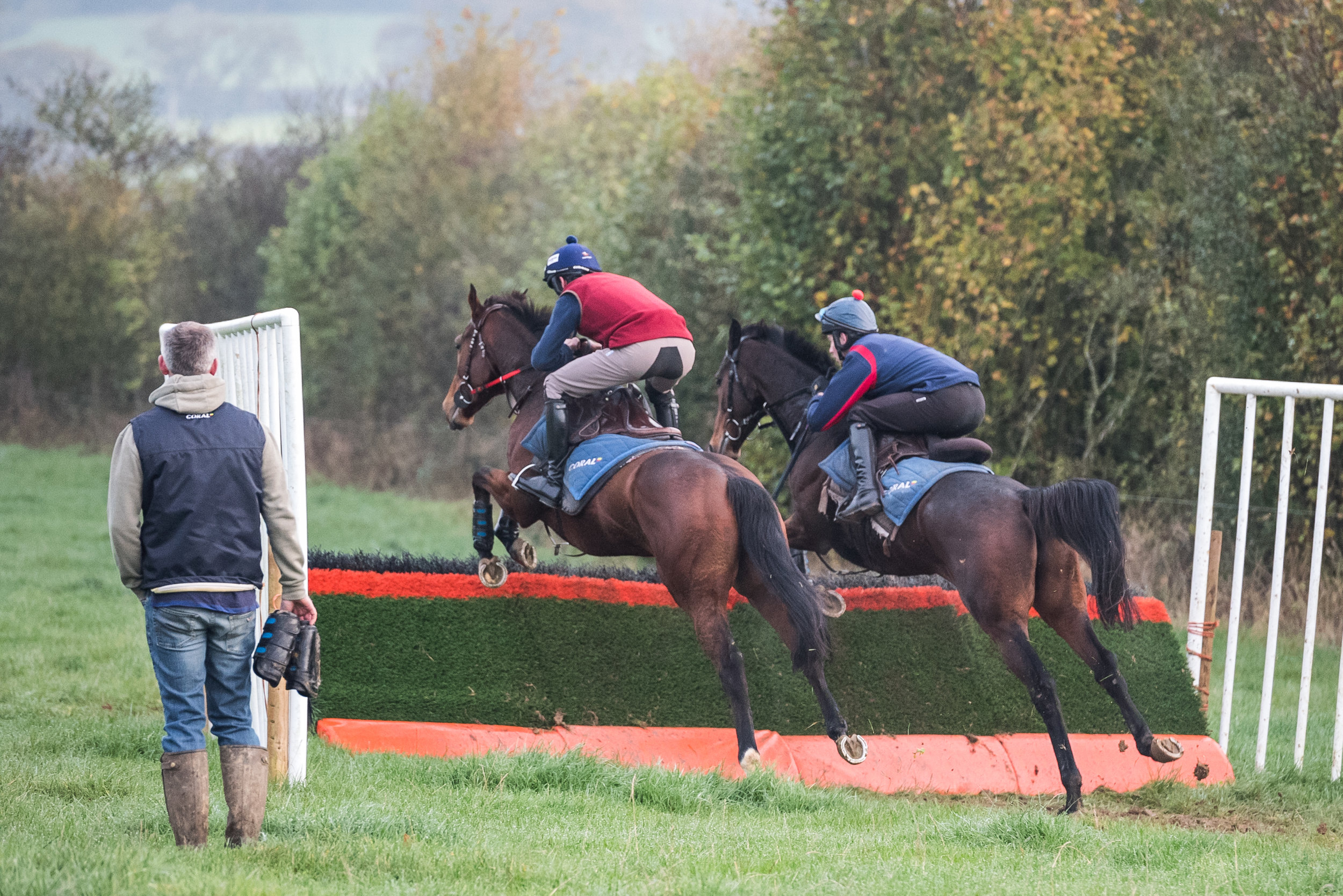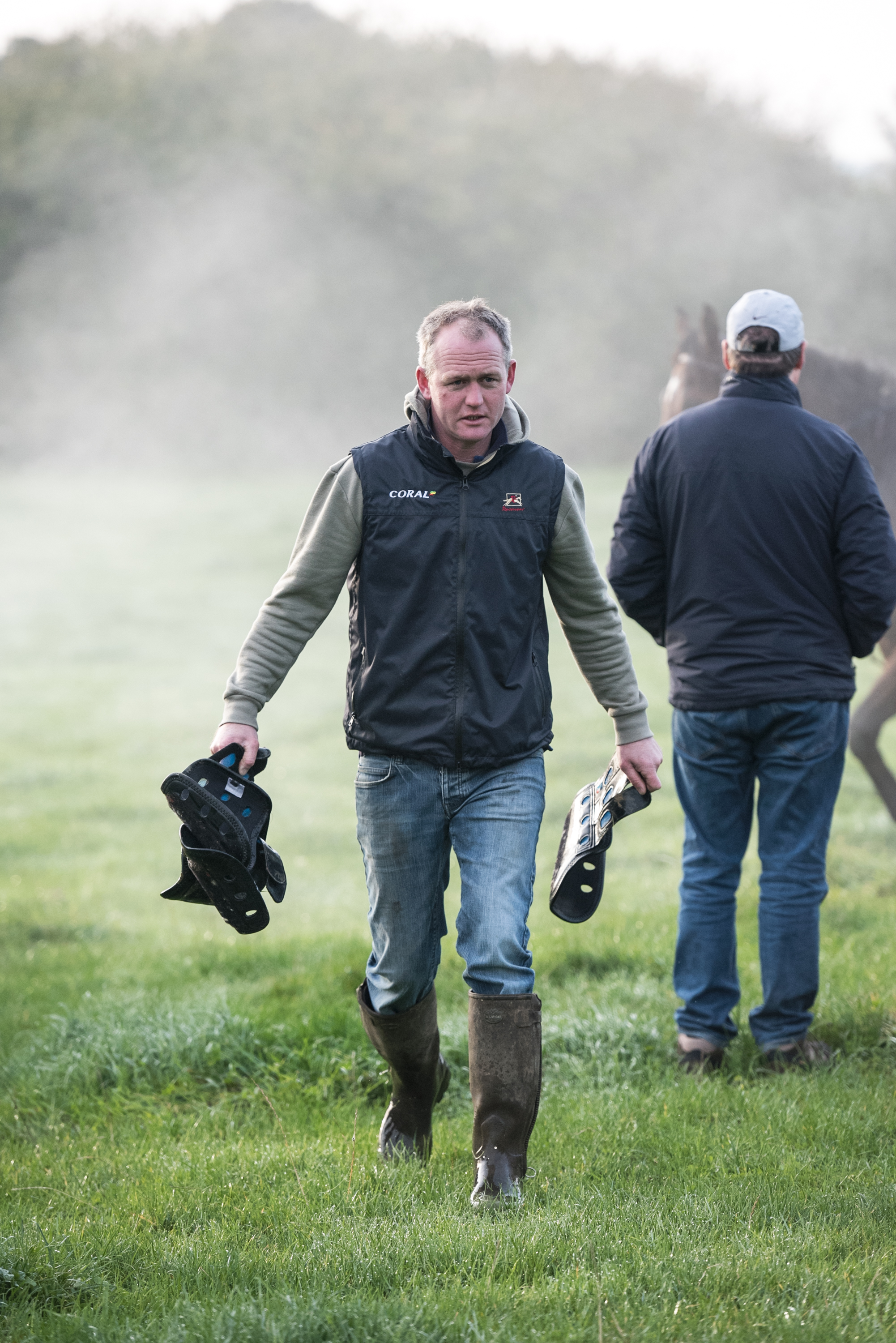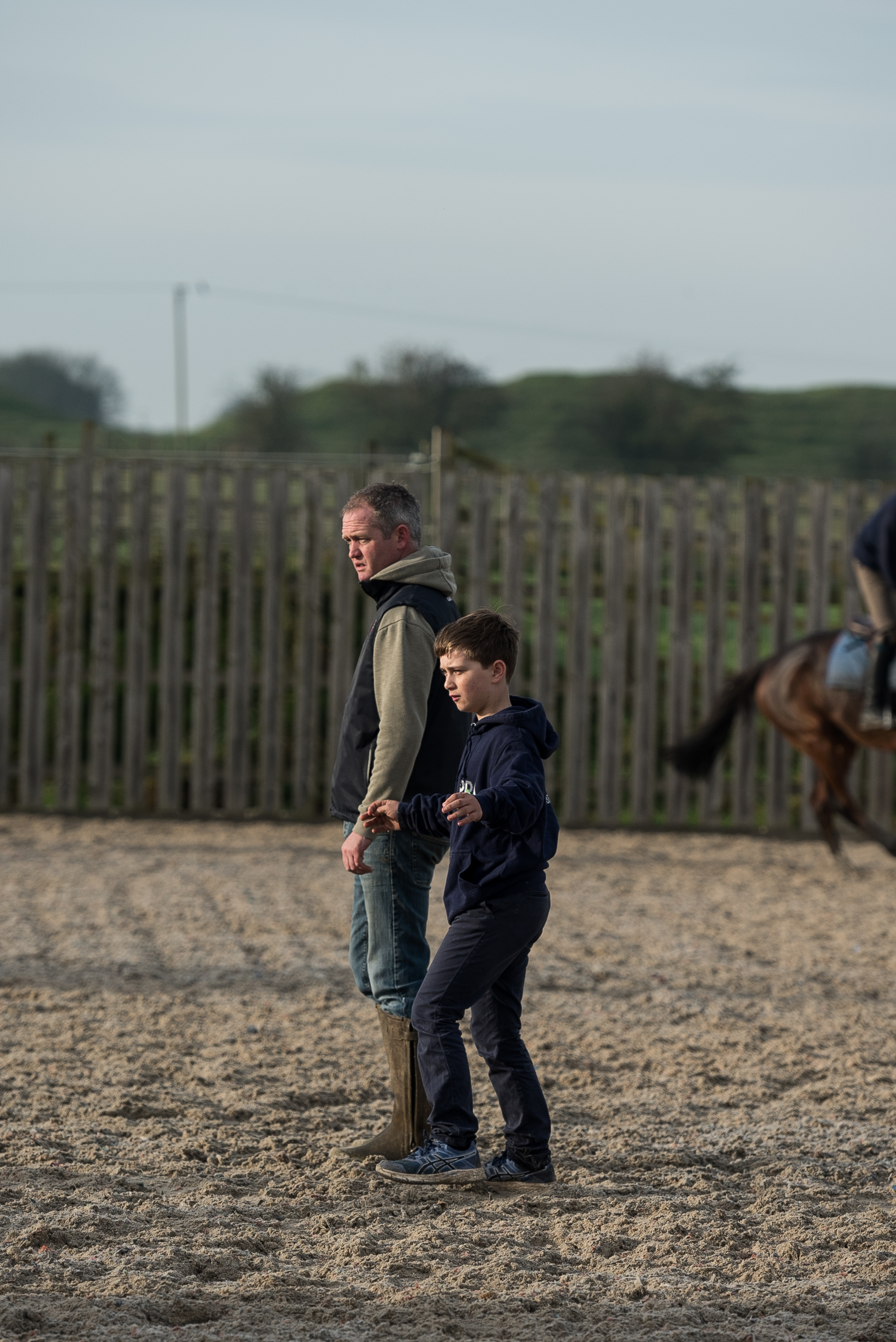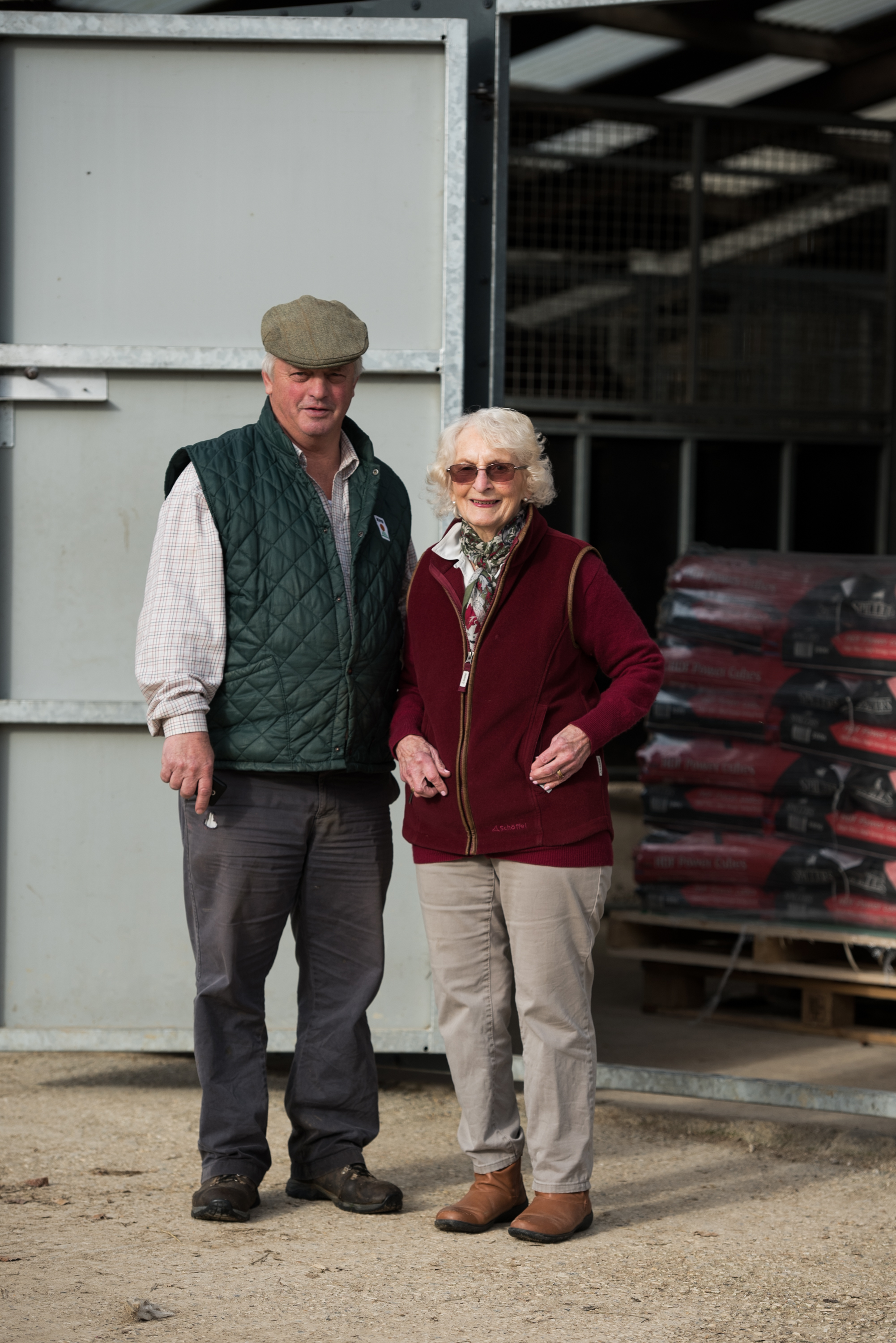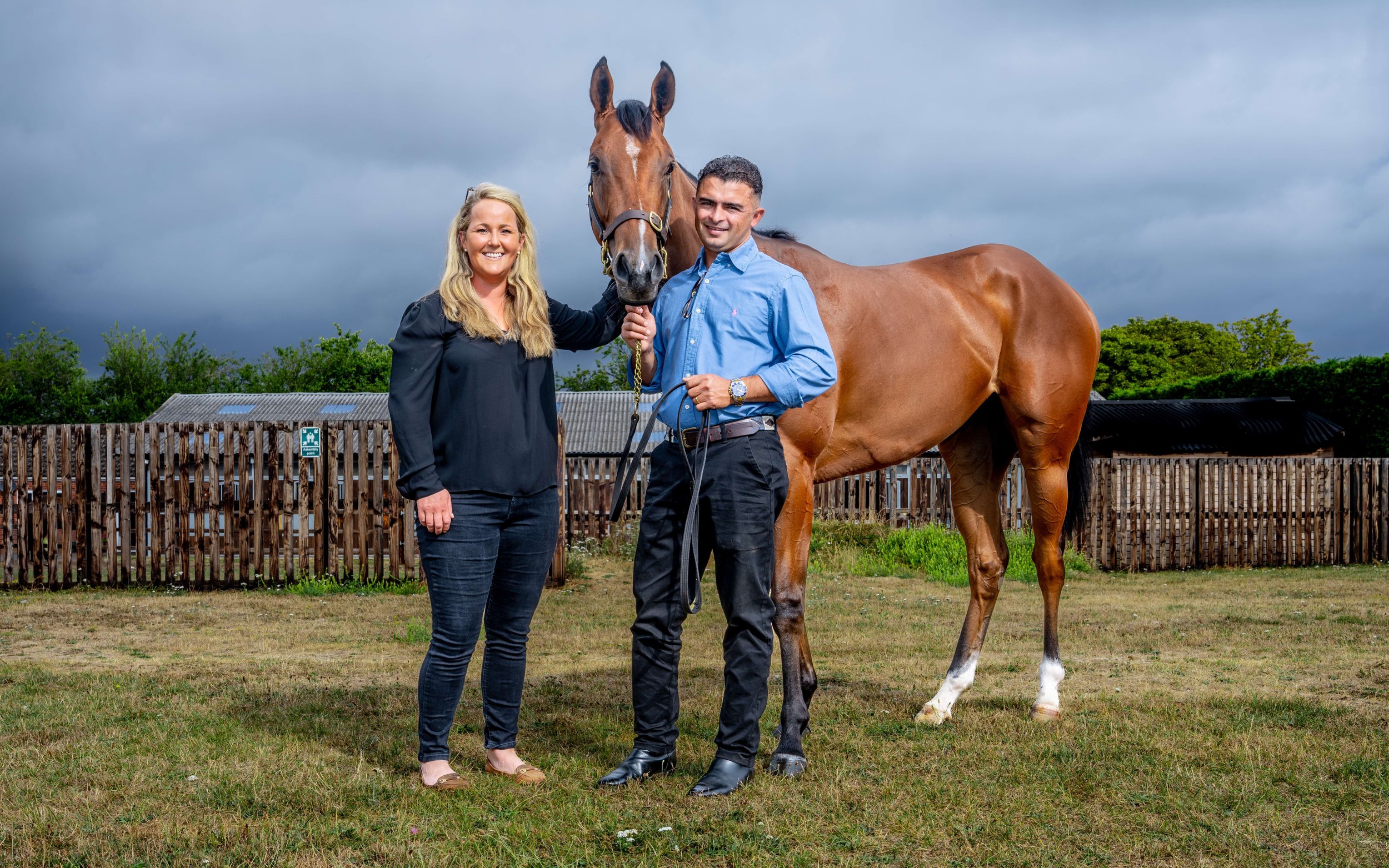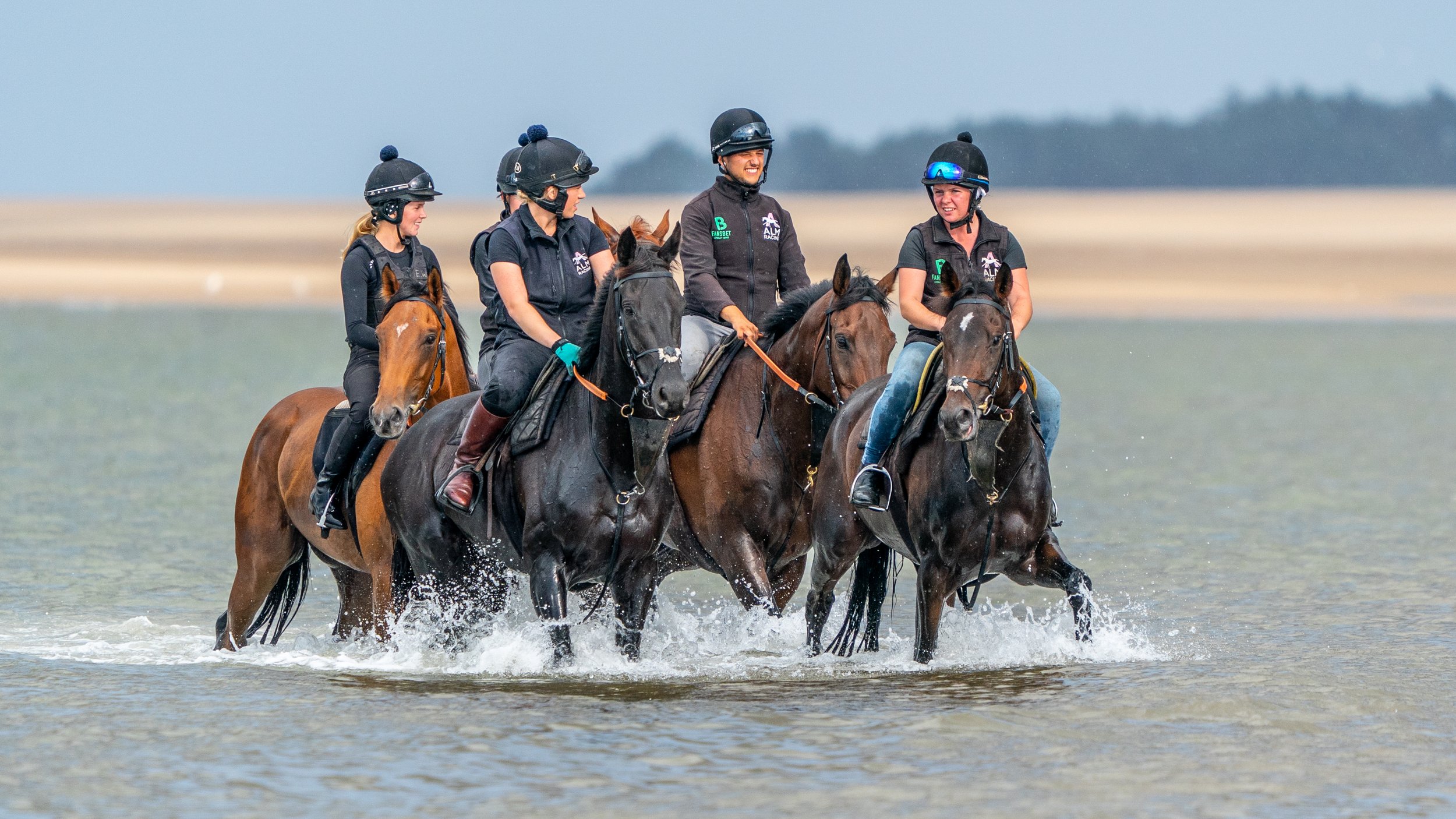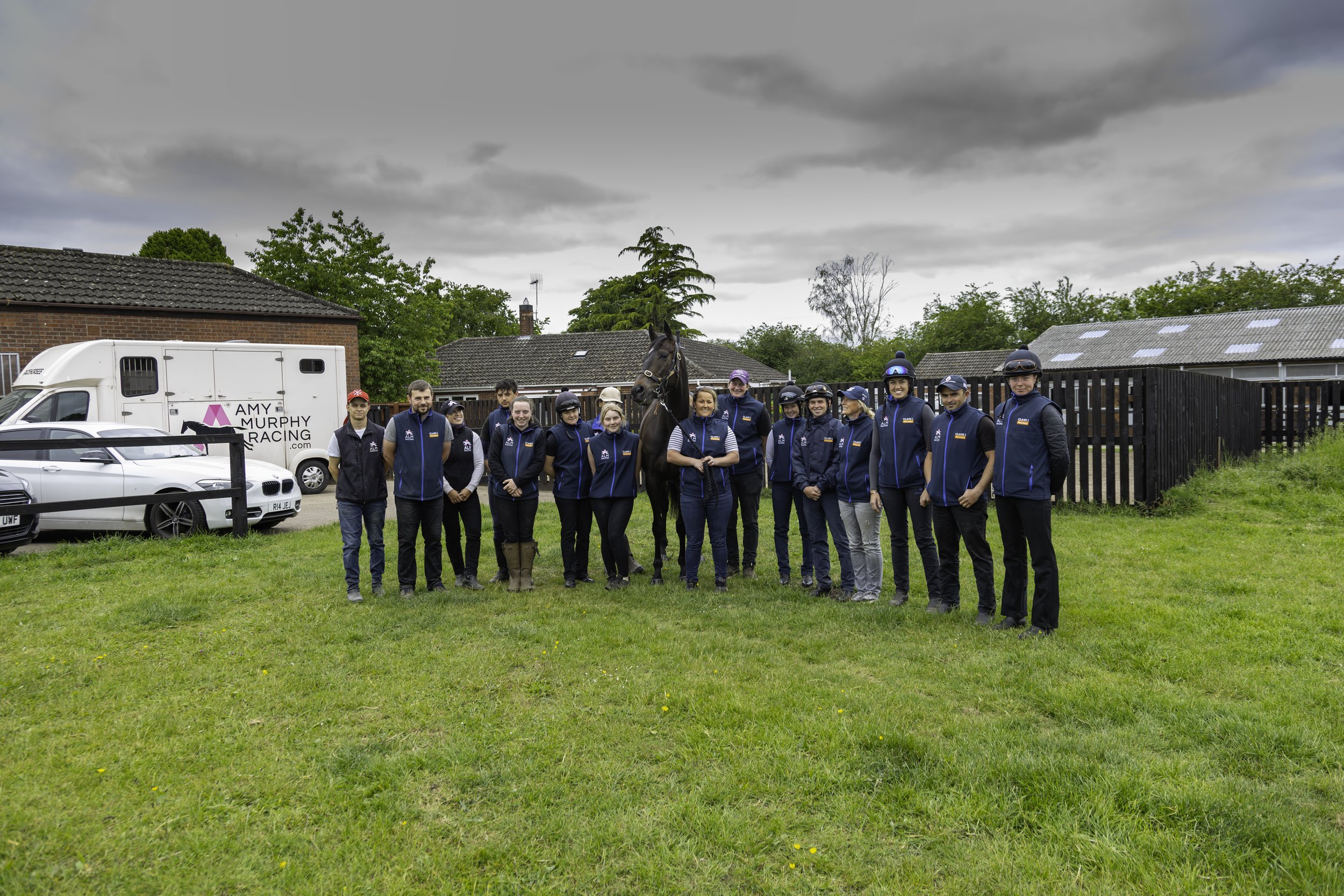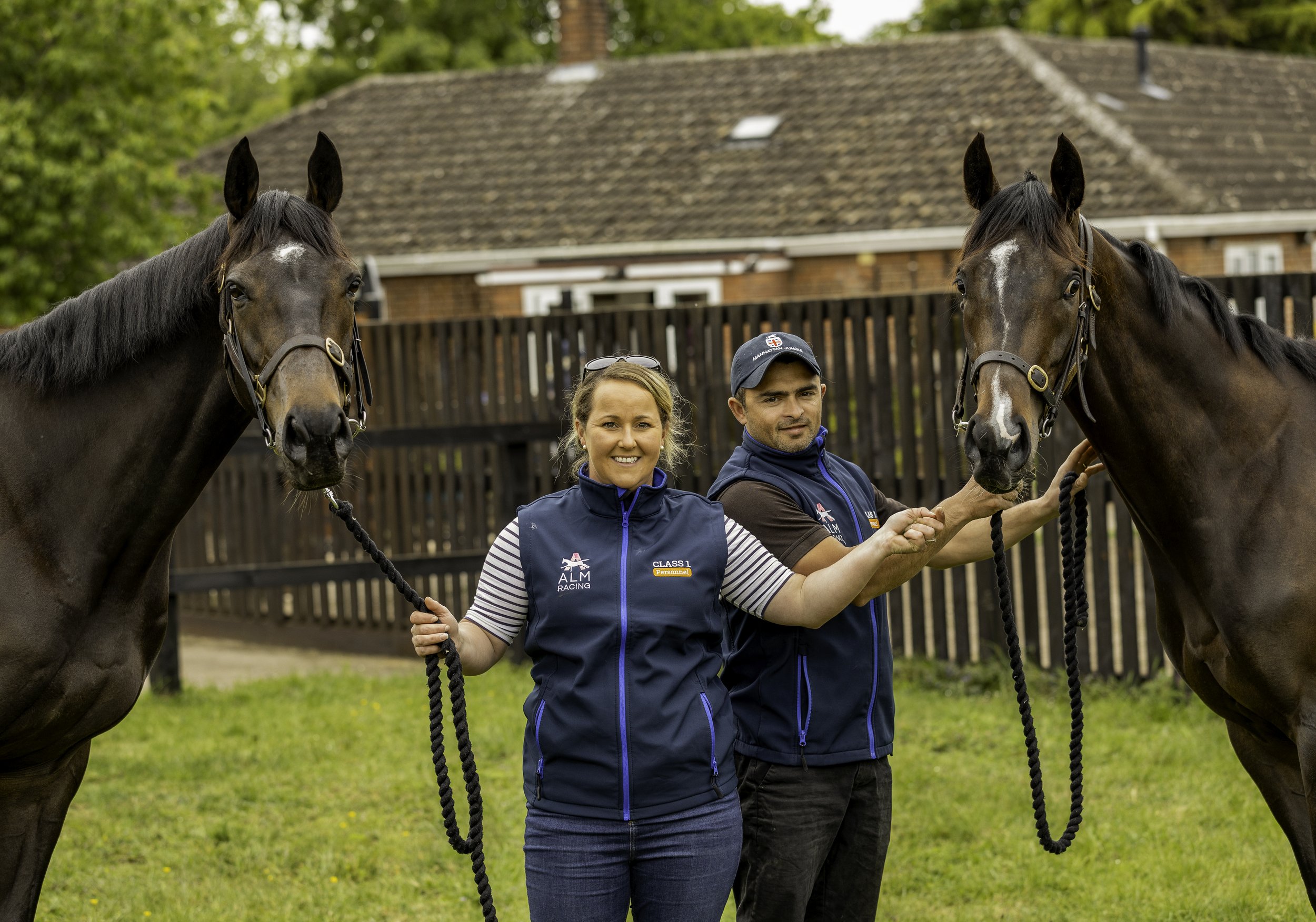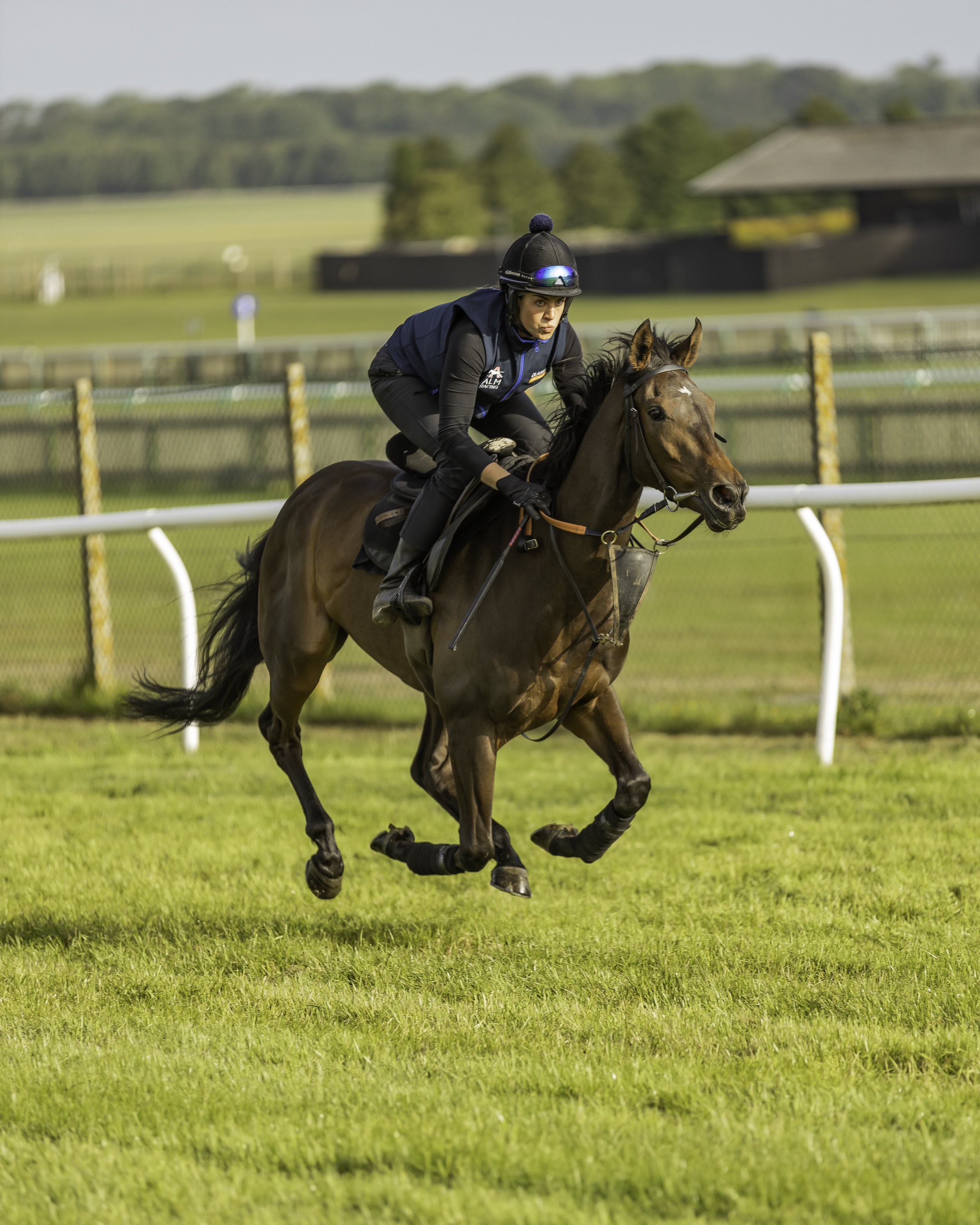Henk Grewe - the Classic winning German Trainer
Article by Catrin Nack
When Grewe retired from race-riding and took up training in 2014, it wasn’t exactly the hottest news in German racing. He had been a middle-of-the-road jockey, never reaching lofty heights. But as a trainer, he has made it to the top of his profession.
Eleven years later and February 2025 - it’s six fifteen in the morning and It's pitch black. The first lot is out already, and Grewe is in the saddle.
The majority of German racehorses are trained on a racecourse. Nearly every main track – think Düsseldorf, Cologne, Hannover, Iffezheim or Hoppegarten – doubles as a training centre. A chosen few have the luxury of private premises, but Grewe shares Cologne racecourse with three other major trainers, and roughly 300 horses.
Shared facilities consist of a trotting ring, and two sand gallops, sand, not fibre. His roughly 78 boxes are split into four stable blocks, of various size and quality. The largest block of roughly 40 boxes was actually a grandstand in bygone times.
Tighter animal welfare measures saw a row of windows being installed, with one row of horses glancing onto the stable alley, the other side enjoying a room with a view to both sides.
Every box is filled generously with straw, something increasingly rare in domestic racing yards. “The year I used sawdust was my worst ever, and I am convinced there is a correlation. Horses feel comfy on straw so there you go.” Three horse-walkers grace the place, one is called “the terrace” as it has no roof. And basically, that’s it. The height of technical racehorse training.
A covered trotting ring is in the distance, but “that’s not mine. That’s Peters [Schiergen, of Danedream fame]” says Grewe.
No saltbox, treadmill, solarium, let alone a pool. Scales somewhere, “but I hardly use them.” He concedes that horses may have a perfect racing weight, “but I need to see that. If a trainer can´t spot it, well….”
There is a simplicity in the whole setup, mirrored in the trainer´s beliefs. “Really, you can train a horse anywhere. Hans-Walter Hiller [who was Champion Trainer in 1999, and whose yard he was attached to as a jockey] trained on a strip next to a motorway, so clearly you don’t need much.”
Grewe’s principles when it comes to readying horses are cut from the same cloth. “The most important thing is routine. Routine. Once the horse figures out what he has to do he can relax in that routine, and he feels secure. I don’t like fresh horses. On average my horses are out three hours a day, it comes down to three things: routine, the feeding, and proper medical care.”
The yard has a couple of paddocks now too, and some horses are turned out in the afternoon. Roughly 23 people work for Grewe, with active and retired jockeys playing a vital part in the morning. Thore Hammer-Hansen is one of them.
Having returned to his roots in 2024, the jockey, with a retainer from Cologne racecourse president Eckard Sauren, wasted little time to take German racing by storm. He combined with Grewe (but not Sauren) to win the German Derby on Palladium (more of him later); the end of the year saw him crowned Champion jockey as well.
Fresh from a trip to Riyadh, where he guided the Marian-Falk Weißmeier-trained, Straight to a respectable 5th place at Gp.2 level, Hammer-Hansen feels slightly under the weather but is full of praise of Grewe, who “is a team-player and a very good trainer”.
Much needed positives after other work-riders declare that the trainer's most remarkable trait is “his bad mood before the first lot”. While such statements are (hopefully) tongue-in-cheek, the relaxed atmosphere with a lot of banter is duly noted; Grewe is usually riding three lots himself and doesn’t shy away from the general chores.
Grewe doesn't miss a beat: while preparing his horse and answering cumbersome questions at the same time, his eye is all over the place and every idleness is (duly) spotted.
It all started inconspicuously. Born in 1982, his parents had a couple of horses, so the foundations were laid early on. “I had to decide whether I wanted to be a professional table tennis player or pursue horses. I felt there was more money in the latter.” The good, the bad and the ugly, money is a recurring theme for Grewe.
It is what drives him, because, quite plainly, “I want to be rich”. Grewe retired from race-riding with a handful of Black-Type wins to his name. With the help of then-business partner Christoph Holschbach he set up a limited company to train racehorses on August 1st 2014, with a mere 12 (bad) horses; his first runner, just 20 days later, was a winner.
They kept coming. It was quantity over quality at first, “I had to get my name out”. In his prime Grewe had roughly 120 horses. The first Listed winner came in 2017, the first Group winner, Taraja in a Hamburg Gp.3, in May 2018. Khan, who eventually switched to hurdles, provided the breakthrough at the highest level when taking the Großer Preis von Europa in September 2018.
The hardy and consistent Rubaiyat flew the flag for four seasons; unbeaten as a 2yo in 2019, he won at least one Group race in every season. While he missed out on valuable Gp.1 glory, his trainers list of high-class winners started growing: the German Derby (Gp.1) twice (Sisfahan and Palladium), the German Oaks (Muskoka), the Großer Preis von Europa (Donjah and Khan), The Großer Preis von Bayern (Sunny Queen and Assistent).
When asked if he has a preference for fillies or colts, the answer is an emphatic “no”. While the German Derby was the highlight of 2024 (next the birth of his son Mikk), the yard won eight more Group races. Having been crowned Champion Trainer in 2019 and 2020, Grewe's focus started to shift.
He still likes to travel, but now it´s for Black-Type and not for claimers. His intimate knowledge of the French racing system means that country still is his preferred hunting ground, along with Italy, where he has won 10 Group-races to date if our counting hasn’t let us down. But gone are the days when for every domestic runner he had two abroad.
Grewe no longer has that number of horses, nor does he want to. “Horse numbers are down [in Germany] because training is just too expensive,” he admits. “Look, I am very open about this but every month my owners part with €3000 per horse. Who can afford that? Look at the prize money and do the maths. Syndicates are the solution, no two ways about it.”
It helps that Grewe has syndicated horses in his yard. While Germany may not be ready for micro share syndicates (even though Hammer-Hansen evidently thinks so), it was certainly ready for a syndicate called Liberty Racing, founded in 2020 by shrewd entrepreneur Lars-Wilhelm Baumgarten and partner Nadine Siepmann. Selling 25 shares at €25.000 apiece (for a bundle of three hand-picked horses) may have taken some persuasion at first, but success came almost instantly; now there is a waiting list.
Buying (and owning) a Group 1 winner in every year since its foundation, Liberty Racing has now won two German Derby’s in a row. Fantastic Moon was their flagbearer in 2023 when taking the blue ribbon for trainer Sarah Steinberg, and Palladium was the winner of last year's race on the first Sunday in July - the traditional date for the German Derby.
Palladium was trained by Grewe, who still marvels in the wonders of it all. After spending considerable time telling me that he doesn’t ‘do’ emotions, doesn’t have a favourite horse and doesn’t get attached to horses, his eyes did light up when recalling that day. “Look, nothing came easy to Palladium and he didn’t excite us at home.” He ran ok as a 2yo [no win] and proceeded to win a small race on his fourth start, before finishing a lacklustre 4th in Germany's main Derby trial, the Union Rennen.
“I am still not sure what wonders combined in Hamburg and how we managed to win there. It was great, especially with my girlfriend being heavily pregnant with our first child [son Mikk was born later that month]“.
So you had emotions that day? “Maybe for five minutes,” he smiles.
Mikk naturally changed a lot. “Everything changed with him, and I wonder what I did all day before he came. We came home from a holiday the other day, so many suitcases and his buggy. I thought - clearly we need a bigger car! I don’t think it changed the way I train, but I do feel more pressure to succeed, to earn money as I want him to have every chance in life.” The money, right? No emotions, right?
Palladium of course went on to write his own chapter in Grewe's (and Liberty Racing’s) vita when selling for €1.4 million at last year's Arc Sale. This made him the highest-priced horse ever to go hurdling and joined Nicky Henderson’s famed Lambourn stable. He was a winner on his first start over the smaller obstacles at Huntingdon in late January. But, come this summer, an ambitious flat campaign may beckon too.
It's not that Grewe and Liberty Racing are resting on their laurels. The latter naturally features prominently on Grewe's owners list, with five 3yo’s for three different syndicates. Among those is a strapping son of Camelot, purchased for €180,000 at the 2023 BBAG Sales and from Röttgen Studs fabled A-damline.
Called Amico, and stabled in the same block that housed Assistent and Muskoka, Grewe asks, “do you want to see this year's Derby winner?” Well that is some introduction. History in the shape of three Derby winners in a row would beckon for Liberty Racing, and while that’s not unprecedented in the annals of the German Derby, it certainly hasn’t been done with shared ownership.
Nowadays Grewe trains roughly 80 horses and runs a tight ship. “It´s too expensive to have a bad horse in training and I am quick to call a spade a spade. Not everyone likes that.”
He always has an eye on the strike-rate and had nearly 30% winners to runners in 2024. His horses are brought along a little slower nowadays, but 2yo racing with its lucrative sales races is vital to his business. “Nothing wrong with training 2 year olds, in fact they need it and studies clearly show the benefit of starting early. I am no fan of pre-training though.”
He calls a spade a spade when it comes to German racing too, where low prize money, “ineffective” leadership and rival racecourses are his main complaints.
He misses the sense and obligations for the wider good of racing from the latter group in particular, but feels the tide is ever so slowly turning for the better.
“They [the racecourses] need to work together, and with the owners, to create a more potent environment. My impression is they slowly understand. I do speak my mind, and people listen.”
Syndicates, as mentioned, are Grewe’s idea of accelerating fortunes in German racing and he sees responsibilities with trainers, himself included. “I know I need to get much better at communicating with owners, and yes, no doubt trainers could – and should – set up racing clubs and syndicates.”
Grewe remains as hungry as ever, if not hungrier. “I have won nearly everything worth winning in Germany, but there is loads left abroad.” Eckhard Sauren's horse, Penalty - a rare son of Frankel on these shores, is pencilled in for European Gp.1 mile races.
Constant rumours suggest that Grewe is only biding his time in Germany, but more imminently he plans to take the helm of his training company buying out his (new) business partners in 2025. New chapters will be written, and the best is surely yet to come.
Point-to-Point racing and its role in developing jumpers
Article by Daragh Ó Conchúir
There has always been something special about a well organised point-to-point.
It is social, in the truest sense. A communal gathering of like-minded people, with a love of rural pursuits and lifestyle.
It is racing at its purest too, founded on the genesis of steeplechasing in the Irish county of Cork in 1752. That was when Edmund Blake and Cornelius O’Callaghan chose to resolve which of them possessed the best steed by racing the four and a half miles from Buttevant Church to its Doneraile counterpart. Steeple to steeple, taking whatever route they saw fit and clearing whatever obstacle was in the way. Naturally, the money was down to increase the stakes.
Good horses often emerged from this sphere, with Tom Costello a legendary source of Gold Cup winners, but that wasn’t the raison d’être. Pointing was a leisurely pursuit. There was no competition for National Hunt trainers when it came to the acquisition of stores or younger jumping stock.
The landscape began to change with the introduction of an autumn point-to-point season by Irish authorities to make up for the fixtures lost by the outbreak of Foot And Mouth in 2001 but the last decade has seen an increasing commercialism that has altered the face not just of point-to-pointing, but of racing under Rules.
This has only accelerated by the reduction in availability of the good Flat handicappers, now flowing to jurisdictions such as Hong Kong and Australia with mammoth prize money justifying the eye-watering sums that National Hunt people could not justify.
There is always a risk with buying thoroughbreds but for end users, that is alleviated somewhat when there is form with proven depth. Of course there is a premium on that.
The results speak for themselves when it comes to the question of whether or not the sector is developing jumpers to a requisite level. Just look at the recently concluded Cheltenham Festival, where of the 27 races, nine were won by graduates of the point-to-point circuit – eight from Ireland and one from Britain. That latter success was in the point-to-point feature, the Foxhunter Chase, as Sine Nomine repelled the strong raiding challenge for Fiona Needham, her father Robin Tate and jockey John Dawson.
What is notable though is the high level of achievement. Of the other eight graduates from the point scene to score, five did so in Grade 1s: Slade Steel (Supreme Novices’ Hurdle), Ballyburn (Gallagher Novices’ Hurdle), Fact To File (Brown Advisory Novices’ Chase), Jasmin De Vaux (Champion Bumper) and Stellar Story (Albert Bartlett Novices’ Hurdle). There was a clean sweep of placings by ex-pointers in the Brown Advisory and Albert Bartlett.
This is not anything like a one-off, of course. When Colin McKeever’s Loughanmore winner, Ballyburn, sauntered to a 13-length triumph in the Gallagher, he was the fourth alumnus of the sphere to land the spoils in that particular Grade 1 in five seasons. Slade Steel was the fourth to bag the Supreme in the same period. That’s Constitution Hill, Shishkin, Envoi Allen and Bob Olinger we’re talking about between the two.
There is depth in terms of the handlers producing these talents also. Donnchadh Doyle, whose brothers Seán and Cormac are established providers with the likes of Monkfish, Holywell and Bravemansgame included on the roll of honour, was the only provider to have multiple winners, having guided Fact To File and Stellar Story to successes at Bellharbour and Castlelands.
Apart from the aforementioned McKeever, Pierce Power, Colin Bowe, Euguene O’Sullivan, Stuart Crawford and Warren Ewing had the satisfaction of seeing former charges deliver on the biggest stage.
It is significant too that the octet won their maidens at eight different venues, illustrating the calibre of the tracks.
The growth in the sector and the unarguable evidence that this system is working is seen in figures provided by Irish point-to-point website, p2p.ie. If we take the past 15 completed jumps season from 2008/09 to 2022/2023, we see a progression from when graduates won 725 track races, eight of which were at Grade 1 level, to a stunning 1570 winners and 27 elite successes. The total number of black-type winners increases from 39 to 98.
Since 2015/16, the number of winners has only dropped below 1400 once, and that was in the Covid-impacted 2019/2020 term.
While the number of winners has largely been consistent – 1718 in 2020/21 was a high-water mark – the quality continues on an upward climb, with 27 Grade 1s secured by Irish point products in two of the last three seasons with completed figures.
And that is why the prices continue to rise. The record for the most expensive point-to-pointer was set in November 2020, when JP McManus shelled out £570,000 for Jonbon at the Goffs UK Sale in Yorton after the full-brother to multiple Grade 1 winner Douvan had cantered to a 15-length triumph for Ellmarie Holden, Paul Holden and Michael Shefflin.
At the Punchestown Festival Sale 12 months ago, it was a mare that attracted the biggest bonanza, as Mags O’Toole spent €500,000 on behalf of Brian Acheson’s Robcour ownership banner for Qualimita, who had dotted up in a Fairyhouse maiden by 30 lengths for Walter Connors and Bowe.
A highest price for a British filly pointer was set last May, when Saunton Surf was sold in May for £175,000 by Brad Gibbs to Warren Greatrex at the Goffs Spring Sale in Doncaster.
That was matched last December, as Just A Rose was bought by Tom Malone, for British champion trainer Paul Nicholls, from Tom Ellis and breeders Sarah and Nigel Faulks. The same buying combination snapped up Will Biddick’s facile Badbury Rings victor, No Drama This End for £160,000 at the Cheltenham Festival Sale in March.
Meanwhile, Eddie O’Leary signed a chit for €265,000 at the Tattersalls Ireland Derby Sale last June for a store that was heading in Gordon Elliott’s direction and in all, 33 horses sold for €100,000 or more at that auction, making it the third best result in Derby Sale history.
And remember, a Camelot half-brother to Altior realised a staggering €155,000 at the Tattersalls National Hunt Sale in November 2019, purchased by former Republic of Ireland soccer international Kevin Doyle from Coole House Farm on behalf of Paddy Behan Jnr. It was the highest price paid for a foal at the sale for 12 years and the third highest in its history.
While the most recent auctions might finally be suggesting a slight correction, Irish producer and trainer, Liz Doyle wasn’t far wrong when she described the point-to-point sector as ‘pandemic and recession-proof’.
Jerry McGrath is relatively new to the scene as a bloodstock agent, a role he took up upon his injury-enforced retirement at the beginning of 2022. But the Cork native had long been tasked by his boss Nicky Henderson with keeping an eye on the Irish point-to-point circuit during his time at Seven Barrows, during which he rode two Cheltenham Festival winners.
Love Envoi provided him with his first Cheltenham triumph as a buyer. Jango Baie is a Grade 1-winning novice hurdler this year and Jingko Blue is another youngster acquired from racing through the flags that has made a good transition to the track.
“It’s been well documented; it’s harder to get hold of these highly rated, staying flat horses now because there’s such a market for them abroad,” says McGrath. “Because that has happened it has narrowed where you get your jump horses from and I think that’s why maybe the point-to-point thing has come so strong.
“Of course, it has been massively influenced by the point-to-point handlers themselves. I have the utmost respect for those lads. They go out there, they put their money on the line, they invest in horses that they like at the store sales. We’ve seen in the last three or four years, they’ve been outbidding plenty of trainers.
“When you look at it like that, it sounds a bit bonkers that the point-to-point men are outbidding the end users, bearing in mind they have to prove the horse’s ability, with the hope that the end user comes back and buys it as a winning point-to-pointer.”
This is why not every trainer is a fan, as they are now priced out of the market at both potential entry points –sales for stores and pointers. But in an open market, those willing to risk the most, make the most. The vital element to it all is the emergence of talented animals on a consistent basis.
The handlers are clearly discerning in their sourcing too. While there are fashionable stallions, the point graduates that delivered at Cheltenham came from a variety of sires: Flemensfirth (Ballyburn), Shantou (Stellar Story), Poliglote (Fact To File), Telescope (Slade Steel) and Tirwanako (Jasmin De Vaux) were the Grade 1 performers, while Gamut (Corbetts Cross), Milan (Better Days Ahead) and Saint Des Saints, whose three winners at the festival included Sine Nomine, completed the crop.
This is why McGrath’s priority is the model rather than the page, although pedigree has to be taken into account.
“You can have a potential superstar but if he’s a terrible mover, his longevity is going to be very short. It’s a bit like cheap speed, the two-year-old that’s going out very early. You might win a two-year-old maiden at the start of the year but will you be there at the end of the season competing in group races? Probably not. So you do have to have an athletic horse.
“Temperament definitely comes into it but at the same time, these are young horses, and their temperament can be managed, especially if they go into the right hands. If you’ve got a hot and buzzy horse, it doesn’t mean they’ll be hot and buzzy in two years’ time.
“Athleticism and movement is the big thing for me. And you have to have a bit of pedigree. If they’re not bred to be a good racehorse, why would you be surprised they’re not a good racehorse?”
Pat Doyle is one of the enduring characters of the Irish point-to-point sector, having been among the pioneers for using it to sell four and five-year-olds with form before the likes of the Wexford crew of Bowe, Denis Murphy and the unrelated Doyle brothers raised the bar. He kept up with the evolution though and had at least ten graduates running at Cheltenham. The majority of them were trained by Mullins, which is no mean imprimatur.
It is 50 years this year since Doyle broke future dual Champion Hurdle winner Monksfield as a two-year-old. Later on, he pre-trained Minnehoma for his good friend Roddy O’Byrne to sell. Minnehoma followed Cheltenham success with a famous Grand National victory in 1994.
Bob Olinger, Appreciate It, First Lieutenant, Shattered Love, Colreevy, Readin Tommy Wrong, Bacardys, Commander Of Fleet, Champ Kiely and Brindisi Breeze are just some of the other Grade 1 and Cheltenham winners to have emerged from his academy.
The very latest off the production line, Ballycahane winner In The Age, sold at the Cheltenham Festival Sale for £100,000 to Ryan Mahon for the leading British trainer at the festival, Dan Skelton. The headline act at this boutique offering was the purchase of Echoing Silence by Peter Molony from Sam Curling and Correna Bowe for £410,000, to be trained by Henry de Bromhead.
This sale has produced the last two Gold Cup runners-up, Bravemansgame and Gerri Colombe, while three of its graduates from the 2023 sale participated in the Champion Bumper this March, including the runner-up Romeo Coolio and third-placed Jalon D’Oudairies.
“The biggest trick is selling them to good trainers,” Doyle relates. “I’ve been very, very lucky with Willie Mullins, Henry de Bromhead and fellas like that buying horses off me that turned out to be successful. I’m an open market for anyone to buy horses off but Willie Mullins (had) seven or eight horses I sold him running at Cheltenham.”
For a long time, Doyle and his fellow Irish handlers had this niche to themselves. The likes of Sophie and Tom Lacey were trading but the point-to-point arena remained Corinthian in spirit and action.
The old traditions are gradually being cast off with the likes of Gold Cup runner-up Santini (Ed and Polly Walker) and Ahoy Senor (Melanie and Philip Rowley) having emerged and with handlers of the calibre of Tom Ellis and Gina Andrews, Bradley Gibbs, Fran and Charlie Poste, Josh Newman and Kayley Woollacott and Will Biddick in the vanguard of those guiding young talent.
Tom Lacey is now training under Rules, but having produced dual Champion Chase winner Energumene, Sebastapol (this pair won two divisions of the same open maiden at Larkhill in January 2018), Blackbow, Kimberlite Candy and the most expensive British pointer ever Interconnected (sold for £220,000 after winning at Larkhill in a month after Energumene and Sebastapol), remains an ardent advocate of the division on his native shore.
“I think it’s irreplaceable. I don’t believe there’s any better grounding for jumps horses than point-to-points,” Lacey states definitively.
“Ten years ago you could send a well-educated horse 80 per cent fit to an English point-to-point and you’d win it stylishly. Now you need to be well educated and be a 100% fit. There’s plenty of depth there now. There’s more and more people doing it and you’ve got plenty of good, sharp lads doing it.
“I think there’s still an element where the British point-to-point programme needs to be tweaked… For example, this is the time where your four-year-olds start coming to fruition. You know where you are with them, you’re ready to run and this weekend they’ve got a five-year-old and over maiden point-to-point. Well that’s just stupid.
“They have also introduced these point-to-point Flat races. The issue I have with those is they have diluted the maidens. They have taken away a lot of the young horses which would traditionally have run in a point-to-point. And now the people that don’t want to be commercial fiddle around for a season running around in these point-to-point Flat races and to be quite honest with you, they’re dirt. You won’t sell a horse out of one of them. They should never have been allowed to come in.”
Does it damage the reputation of the product?
“Yes it does. All of the boys operating on a commercial basis won’t entertain them. If you want to sell a horse, it needs to be able to jump 16 or 18 fences and do it nicely.”
McGrath has plenty of praise for the British scene.
“There is talent emerging and we’d love for it to be stronger again but sometimes, people struggle to get a grasp on the English form, whereas a lot of people know the Irish point-to-point handlers better, they know the tracks better and can get a better handle on the form but at the same time, it doesn’t mean that there’s not lots of good horses come out of English point-to-points.
“I think sometimes there can be a bit of value and when you are buying pointers, it is important to remember that it is budget driven and you don’t always have to shell out the big numbers to buy a good horse.”
Lacey and Doyle are in agreement about the importance of producing a racehorse over a sales horse. It is the only way to ensure longevity as a commercial entity.
“There’s no point trying to sell a mediocre horse for a lot of money ‘cos you’ll only ever do it once,” Lacey declares. “We had a horse won at Dingley Point-To-Point (by 16 lengths) called Space Safari. Bryan Drew was there that day and rang me up that evening and said, ‘What do you want for that horse?’ I said, ‘Bryan, I can’t sell him to you. Don’t ask me any more questions but I can’t sell him to you.’ And that was because I wanted him to come back and buy another one.”
“I don’t want to sell a bad horse,” is the Doyle mantra. “I had a few horses in Cheltenham at the (February) sale. They made good store prices, but I explained to the guys that bought them, ‘This is what these horses are capable of doing. They’re good horses. Are they Saturday horses? Maybe not, but they’ll win races.’”
When a vendor is known for this sort of honesty, buyers take note when he vouches for a horse. Doyle’s word was enough for Willie Mullins to acquire Appreciate It, Champ Kiely and Readin Tommy Wrong despite them failing to win their maidens but they are all Grade 1 victors now.
And of course, Nicky Henderson bought Constitution Hill because of his respect for Warren Ewing and his former No 1 jockey Barry Geraghty, who had sold him future Gold Cup winner, Bobs Worth. Constitution Hill finished second in his point at Tipperary, after making a terrible mistake at the last. What’s more, the physical exertions left a toll. It was only the word of men he knew and trusted that maintained Henderson’s interest. As we know, the Blue Bresil seven-year-old has yet to lose a race on the track and sauntered to a Champion Hurdle success last year before illness ruled him out this time around.
Some horses are just slower developers. Grand National winner Corach Rambler, who ran a stormer to be third in the Gold Cup and is a short price to back up his Aintree heroics, took five attempts to win a point for John Walsh, finally getting his head in front in a six-year-old’s and older maiden at Monksgrange in September 2020. So a relationship and trust with the vendor is critical.
“A very good example was Love Envoi,” McGrath explains. “She didn’t show herself very well on the day and there was a minor vetting issue but Seán (Doyle) assured me it had not stopped her and it would have surprised him if it ever did cause an issue. We paid thirty-eight grand for her and she turned out to be a Cheltenham Festival winner, a multiple black-type filly and a Grade 1-placed filly. That was a perfect example of trust.”
It is noteworthy how often Mullins’ name crops up in the course of these discussions, reflective perhaps of his dominance. What is interesting is how often he gets his business done privately, via his agent, Harold Kirk, with Pierre Boulard his man on the ground in France when it comes to acquiring the talent emerging from French three and four-year-old hurdles. Lacey is adamant that this, more than anything else, is why he is the leviathan of jump racing.
“People say, ‘What’s Willie Mullins doing that allows him to get all these best horses?’”, the Cottage Field Stables conditioner begins.
“If you’ve got a good horse and you genuinely believe it’s a graded horse, if you ring Harold Kirk and say, ‘Harold, I’ve got one for you,’ he will say, ‘What do you want for it?’ You’ll name your price and he will say, ‘I’ll have it.’
“That is what Willie Mullins does differently. He doesn’t say, ‘I’ll come back to you in a week’s time.’ The vet’s there within the week and they just get the business done. They do not sit on the fence and allow horses to be sold from underneath them. That is one of the things he does that no one else does. They are so straightforward.
“He’s got Harold Kirk working from November onwards with all the point-to-point handlers working in Ireland, with the point-to-point handlers in England. He used to come over and see all mine before Christmas, see which ones he liked, asked me which ones I liked and if they did what I expected them to do, I rang him up and said, ‘Harold, you should buy that horse.’
“‘I’ll have it.’
“That’s what Willie Mullins does that no one else does.”
Horse Racing Ireland has intimated a willingness to develop a programme of bumpers and hurdles for three-year-old store horses, while there is a programme of junior NH hurdles in Britain, though for paltry prize money.
This comes on the back of the success of the French programme of three-year-old hurdles that is backed with significant prize money by France Galop and is producing major talent. The first of the year was held at Compiegne on March 5, with the connections of Willie De Houelle landing €27,140 for a four-length triumph, the total prize fund amounting to €59,000.
The Beaumec De Houellle gelding is trained by Arnaud Chaille-Chaille, who also was responsible for the sire winning at Grade 1 level. His best graduate, however, is Galopin Des Champs, who won a four-year-old hurdle at Auteuil on debut before relocating to Ireland and becoming a two-time Gold Cup hero.
McGrath has a number of Gallic contacts and sourced the highly promising juvenile, Sir Gino for Henderson from an April maiden at Auteuil. He is a huge fan of a system that also produced the new Champion Hurdler, State Man.
Doyle has reservations about racing moving in this direction though concedes that he would get involved in two-year-old sales if they were to come on stream.
For his part, Lacey believes that this method, while suitable to French-breds, is not necessarily transferable.
“I’d be very old school,” says Lacey. “I think we are all expecting too much too soon from a lot of these young horses. The powers that be want us to follow the French model with Irish pedigrees. We’re breaking a lot of horses at two, turning them away, bringing them back at three and turning them away. They’re still not ready. I don’t know if it’s the breed or the way we produce them or the way we train them or what, but our horses just don’t come to hand like they do in France.”
And you have to do right by the horse.
“Course you have. But when Energumene was here, the ease with which he did everything was astonishing. The gulf between a good horse and a Grade 1 horse is vast. You see it on the gallops, it just floats everywhere. Everything is so effortless.”
He jokes that he had to buy a lot of stores to find that Grade 1 winner – to be fair, Energumene is a six-time Grade 1 winner – but that is the role the handlers play, taking on risk, filtering the wheat from the chaff.
“They go out, they put their own money on the line, they buy these horses as three-year-olds, they take all the risk. They break them. They canter, they school, they gallop the horses, they run the horses in a short space of time. Ideally they like to sell them as four-year-olds, sometimes they carry over till they’re five-year-olds. The good ones go on and make a lot of money and a profit, but there’s an awful lot of horses don’t even see the track, they don’t make the grade. And there’s plenty ones aren’t as good as they want them to be and if they’re lucky, they wipe their faces with them. That’s why they need the big priced ones because they’re covering the cost of the ones we don’t see or hear about.”
High risk, high reward, providing the ultimate quality control service.
Still special.
Amy Murphy – Thinking Outside the Box
Equuis Photography / Jason Bax
Article by Katherine Ford
“I’m a bit choked up; this horse means the absolute world to me…” Amy Murphy was close to tears at Auteuil in March as she welcomed stable stalwart Kalashnikov back into the Winners’ Enclosure with Jack Quinlan aboard. It was a first success in almost four years for the ten-year-old, although the intervening months had seen the popular gelding performing creditably at Graded level in campaigns interrupted by injury. Connections pocketed €26,680 for the winners’ share of the €58,000 conditions hurdle; but the satisfaction far surpassed the prize money.
“An awful lot of blood, sweat and tears have gone into getting him back, but don’t get me wrong: if at any point we thought that he wasn’t still at the top of his game, we’d have stopped because he doesn’t owe us anything.” Runner-up in the Supreme Novices’ Hurdle at the 2018 Festival and a Grade 1 winner at Aintree the following season, Kalashnikov put Amy Murphy—with her refreshing enthusiasm and undeniable horsemanship—on the map from the start of their respective careers.
“He is very much a people’s horse. He was campaigned from the early days at the highest level, and he had some real good battles as a young horse; and I think that those types of horses that don’t go down without a fight, people lock onto them and follow them.”
From veterans to juveniles
Equuis Photography / Jason Bax
While the achievement of keeping a ten-year-old on form and identifying a winnable race at Auteuil for his French debut is considerable, the success was all the more notable as it came just three days after Myconian had earned connections €15,000 for victory in the Prix du Début at Saint-Cloud—the first juvenile contest of the Parisian season. It is rare to find a trainer with success at both ends of the age spectrum, in two different disciplines, but when you add in the fact that Amy Murphy had crossed the Channel to complete this unusual double, it demonstrates a laudable versatility.
“We try and work with everything we get sent. We’re in a fortunate position where we’ve got the best of both worlds with lots of lovely young horses; but Kalashnikov, Mercian Prince and some of the old brigade have been with us since we started. I started training six years ago, and they were two of the first horses in my yard so they’ve been a big part of my career and still are.”
Twelve-year-old Mercian Prince has racked up a total of 13 wins for Amy since arriving in her fledgling yard from France in 2016, with three of these coming in the past 12 months and including one in Clairefontaine last summer. As with Kalashnikov, patience has reaped rewards with this veteran.
“Mercian Prince is very tricky to train at home—he has a mind of his own, and everything’s got to be on his terms. We do lots of different things with him. He will go three or four times during the year to the beach at Holkham, which is about an hour down the road. It keeps him mentally active. I’m a big believer in freshening them up. I like to string a couple of races together and then give them a week or ten days out in the field at the farm—things like that. It’s fine if you’ve got two-year-olds and it’s a short-term game; but with older horses that you know are going to stick around, you’ve got to keep them fresh.”
From pony-mad to the youngest trainer in Newmarket
Ambitious and determined, Amy Murphy spent her childhood on her father’s Wychnor Park Stud in Staffordshire. “My dad bred National Hunt horses as a hobby. I always had ponies and hunted and showjumped until I was about 16; then I started riding out for local trainers and got bitten by the racing bug. I spent all of my weekends and holidays riding out for as many people as would let me in. My dad wouldn’t let me leave school without any qualifications, so I went to Hartpury College and did a diploma in equine science. The day after that finished, I was in a racing yard.”
After a stint with Nicky Henderson, Amy’s now-characteristic adventurous spirit led her to Australia and an educational season with Gai Waterhouse. “Australia was where I learnt more about spelling horses. Their horses will only have three or four runs together and their seasons are split up so they can campaign them with breaks in between the different carnivals. Gai is obviously brilliant with her two-year-olds and does lots of stalls work with them, and that was another important thing I learnt with her.”
On returning to the UK, Amy joined Tom Dascombe as pupil assistant at Michael Owen’s Manor House in Cheshire, which opened the doors to France for the first time, overseeing his satellite base in Deauville during a summer. Her racing education was completed with four years at Luca Cumani’s stable in Newmarket before setting out on her own in 2016, at age 24—the youngest trainer in Newmarket.
“One of the biggest things I learnt from Luca was making sure a horse is ready before you run. As you become a more mature trainer, you relax more into it; you learn that patience pays off. If you think something needs a bit more time or something’s not quite right, then nine times out of ten, you need to be patient.”
Patience is a virtue
Amy with Pride Of America & Lemos with Miss Cantik.
Amy Murphy may have learnt patience with her horses, but she is impatient with a system that she has had to seek and find alternative campaigns for her horses due to low prize money in the UK. “As William Haggas said to me the other day, I’ve got off my rear end and done something about the situation.” She continues, “It’s very hard to make it pay in England, sadly, so it’s either sit here and struggle or do something outside the box.”
Amy’s first Stakes success came in France in just her second season training, thanks to £14,000 breeze-up purchase Happy Odyssey, winner of a juvenile Listed contest at Maisons-Laffitte and who quickly added more profit by selling for €300,000 at Arqana’s Arc Sale just days later. “From very early on, we’ve targeted France. To start with, it was just the black-type horses; but once I got to know the programme a bit better, we started to bring a few of the others across too.”
The ”we” referred to includes Amy’s husband, former Brazilian champion apprentice Lemos de Souza, whom she met when working for Luca Cumani and who now plays a vital role at Amy’s Southgate Stables. “He’s a very good rider and a very good judge of a horse, and is a great asset to have with the two-year-olds. It’s nice having someone to work with and bounce ideas off. He has travelled all over the world—Dubai, Japan, Hong Kong—for Luca Cumani with all of his good horses.”
French flair
Tenrai & Jade Joyce.
Last year, the pair widened their horizons further with the decision to take out a provisional licence in France, renting a yard from trainer Myriam Bollack-Badel in Lamorlaye. “We were going into the complete unknown. My travelling head girl Jade Joyce was based out there along with another girl; and we basically sent out twelve horses on the first day and between them, they had a fantastic three months. The two-year-olds were where our forte lay and what we tried to take advantage of, whereas we had never had horses run in handicaps in France. So, we had to get the older horses handicapped, and the system is completely different.
Amy with racing secretary, Cat Elliott.
There were plenty of administrative errors early on, as my secretary Cat Elliot was doing everything from in Newmarket; so there were plenty of teething problems and plenty of pens being thrown across the office… For example, I didn’t know you couldn’t run a two-year-old twice in five days, so I tried to declare one twice in five days … little things like that. It was all a learning process, like going back to square one again.”
The operation was declared a resounding success, with eight wins and 15 placed runners during the three-month period, amassing a hefty share of the €276,927 earned by the stable during 2022 in France. Among the success stories, juvenile filly Manhattan Jungle was snapped up by Eclipse Thoroughbred Partners after two wins at Chantilly and Lyon Parilly and was later to take Murphy and team to Royal Ascot, the Prix Morny and the Breeders’ Cup. Meanwhile, another juvenile filly, Havana Angel, earned black type in the Gp.3 Prix du Bois, entered Arqana’s Summer Sale as a wild-card and changed hands for €320,000.
The sole regret is that France Galop only allows trainers one chance with the provisional licence. “We tried to apply again this year but sadly got turned down. Moving over full time is not out of the question in the future.”
Vive la Difference
During her stint at Lamorlaye, Amy had the chance to observe some of the French professionals; and although she stresses, “I wasn’t up at Chantilly so didn’t get to see the likes of André Fabre…,” she also notes, “The gallops men would be very surprised by how quick our two-year-olds would be going regularly. The French seem to work at a slower pace, whereas we are more short and sharp; and we use the turf as much as we can. We would work our two-year-olds in a last piece of work with older horses to make sure that they know their job.”
Impressed by the jumps schooling facilities in Lamorlaye, Amy was also complimentary about other aspects of the training centre. “I like the way that you can get the stalls men that work in the afternoon to come and put your two-year-olds through in the morning. That’s all very beneficial to both the horse and to the handlers because they know each other. Another big thing which I love over in France is that when the turf is too quick, they water it so that you can still train on it in the mornings, even at the height of the summer.”
Even without the provisional licence, Amy Murphy’s name is still a familiar sight on French racecards. At the time of writing in late May, her stable has earned €117,446 in prize money and owners’ premiums in 2023, from 18 runners of which four have won and eight placed.
To reduce travel costs, organisation is key. “I had a filly that ran well in a €50,000 maiden at Chantilly recently, and she travelled over with a filly that ran and won at Saint-Cloud three days later. They were based at Chantilly racecourse for the week and moved across to Saint-Cloud on the morning of the race and then came home together on Friday night. It takes a bit more logistics but financially it makes sense to send two together.” As for the owners, they have made no complaints about seeing their horses race further afield. “Plenty of my owners have been over to France; they love it. I haven’t had one person say they don’t want to go to France yet, anyway!”
Defending an industry
Closer to home, a subject dear to Amy’s heart is horse welfare and the image of racing. On her social media accounts, she promotes the cause and has invited the public to visit her stable to see for themselves the care that racehorses are given. “I’ve had a couple of contacts but nowhere near as many as I’d like. As an industry, we have to show that this image that so many people have of racing is just not true. The only way we can do that is by getting people behind the scenes and letting them see just how well these animals are loved and cared for by all of the girls and guys in the yards. Events like the Newmarket Open Day, when we get thousands of people in to visit the years, are the kind of thing that we need to keep pushing. I want to be in this sport for a long time, so I want to do anything I can to help promote it.”
With advocates like Amy and a generation of motivated young trainers, the sport of horse racing can count on some highly professional, hard-working and modern ambassadors, in the UK, France and beyond.
Trainer Profile: Colin Tizzard
“He’ll win the King George, two years’ time, you wait and see!” Given that the speaker is Colin Tizzard, who has saddled the last two winners of the Grade 1 chase, the opinion carries weight, but a warm chuckle from him downplays the gravity of his statement.
Tizzard, his son Joe, and a group of owners are in jovial mood as they watch a pair of promising young novices school upsides at the trainer’s Venn Farm Stables in Dorset, south-west England.
Home to some of the most successful trainers, past and present, in National Hunt (Jumps) racing, the region has long been a hotbed for the sport and also for Point-to-Point (PTP) racing, a related category of amateur thoroughbred racing over fences which is often a starting point in the careers of National Hunt jockeys, trainers, and horses.
Tizzard is one of a number of trainers in the area who have a background in Point-to-Points and have made a successful transition to racing under Rules. His team has firmly established itself as one of the top 20 National Hunt stables in the country season in and season out, having started with two pointers to support his son’s embryonic riding career more than two decades ago, while also running the family dairy farming business.
The stable’s run of form has notably progressed from very good to excellent in the past three years. Last season was Tizzard’s best to date, when he finished third in the trainers’ championship to the two trainers who have dominated the British National Hunt scene for the past decade or so, Nicky Henderson and Paul Nicholls.
So what has propelled Colin Tizzard to the highest echelons of the trainers’ table?
To read more - subscribe now!
Buy this issue online here
